Remembering the Korean War, 60 years ago
This Friday, June 25th, it will have been sixty years since the beginning of the Korean War in 1950. After decades of Japanese occupation, Korea was divided in two by Allied Forces at the end of World War II, with the south administered by the U.S. and the north by Soviet Russia. Deep divisions built over several years, leading to skirmishes and finally an invasion by North Korean troops on June 25th, 1950. The United Nations sent troops and support from 21 countries to support South Korea, primarily from the United States and Britain. The war lasted for three years, with large advances and retreats on both sides, and many casualties. Hundreds of thousands of civilians and soldiers were killed. The two Koreas are technically still at war since hostilities ended in a ceasefire, not a peace treaty in 1953. Though it is often referred to as "The Forgotten War", I hope this collection of photographs helps us to remember the events of 1950-53, those involved, and the legacy that still remains, sixty years later. (48 photos total)
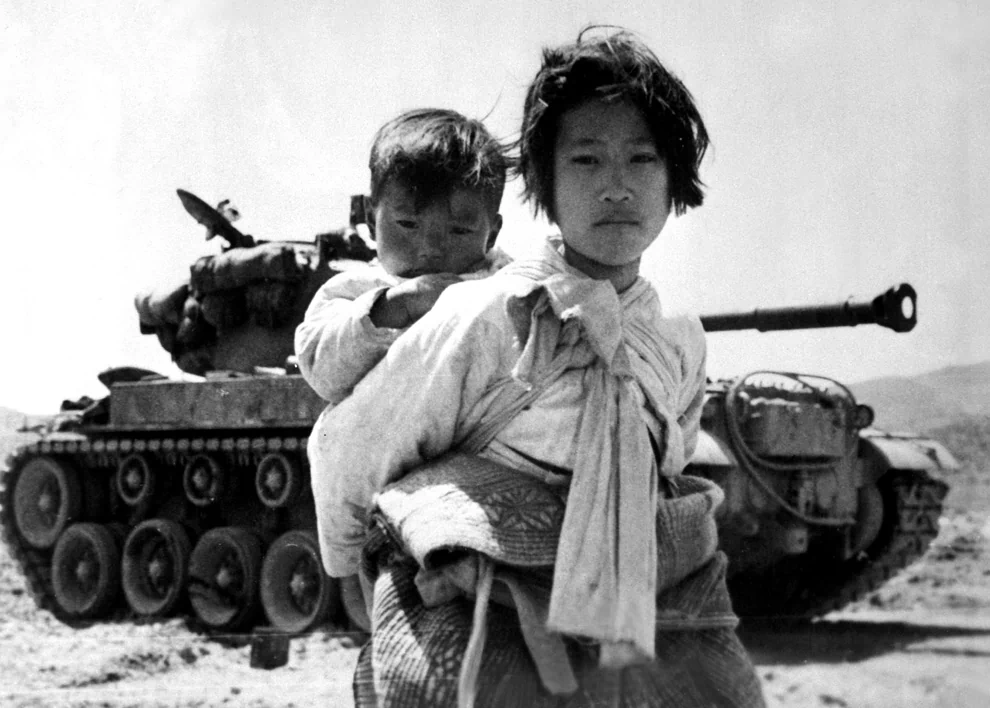
With her brother on her back a war weary Korean girl tiredly trudges by a stalled M-26 tank, at Haengju, Korea. June 9, 1951. (U.S. Navy/Maj. R.V. Spencer, UAF)
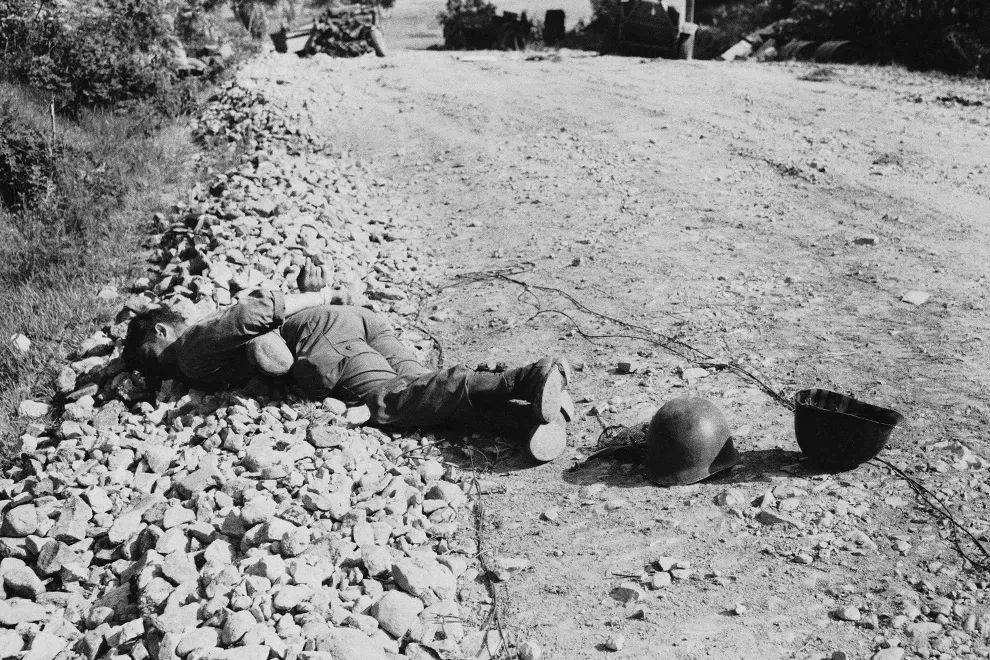
2
One of four American soldiers of the 21st Infantry Regiment, 24th Division, Company, unknown, found midway between the forward observation post and the actual front line on July 10, 1950. The cameraman's caption states that the men were probably captured the night of 9th July, and then shot. Most of them were shot through the head with their hands tied behind their backs. Along with them was a variety of Equipment burned and destroyed. (AP Photo) #
1950年7月10日,在前线和哨岗之间摄影师发现了某连24师21步兵团的4名美国士兵。照片中是4名之一,看来他是7月9日晚上遭枪击的。头部中弹时他们大都双手反绑身后,携带的许多仪器也被烧毁了。(美联社照片)
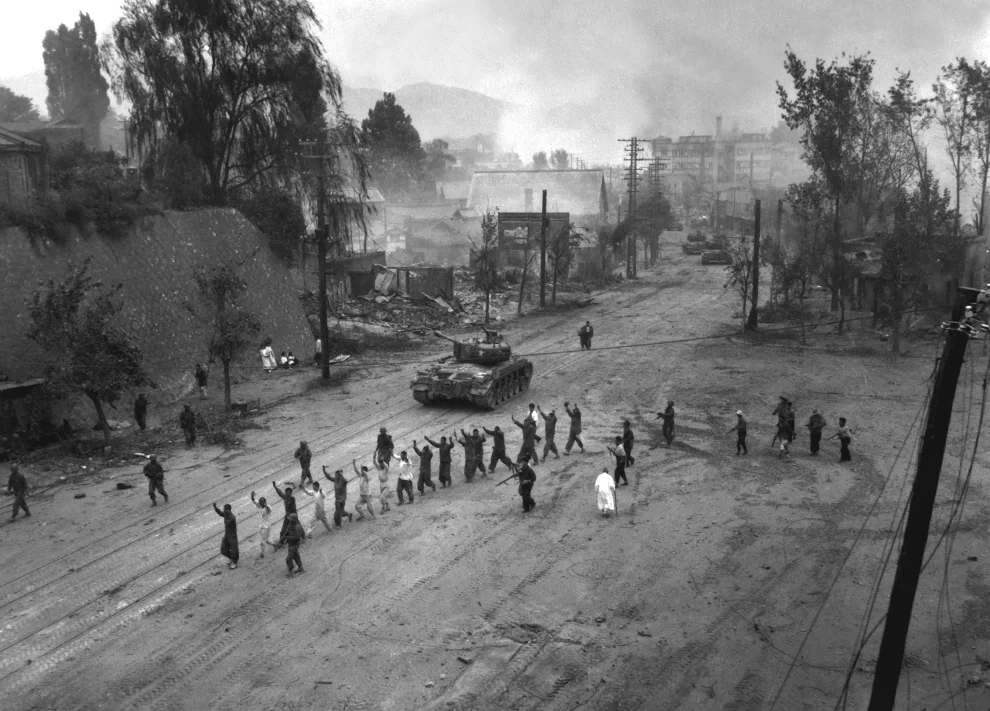
3
A U.S. Marine tank follows a line of prisoners of war down a village street. September 26, 1950. (U.S. Department of Defense/U.S. Marine Corps/S. Sgt. John Babyak, Jr.) #
1950年9月26日,一辆美国海军陆战队的坦克在乡间小路上紧随一队战俘。(美国国防部/ 美国海军陆战队/ 陆军上士 John Babyak, Jr.)
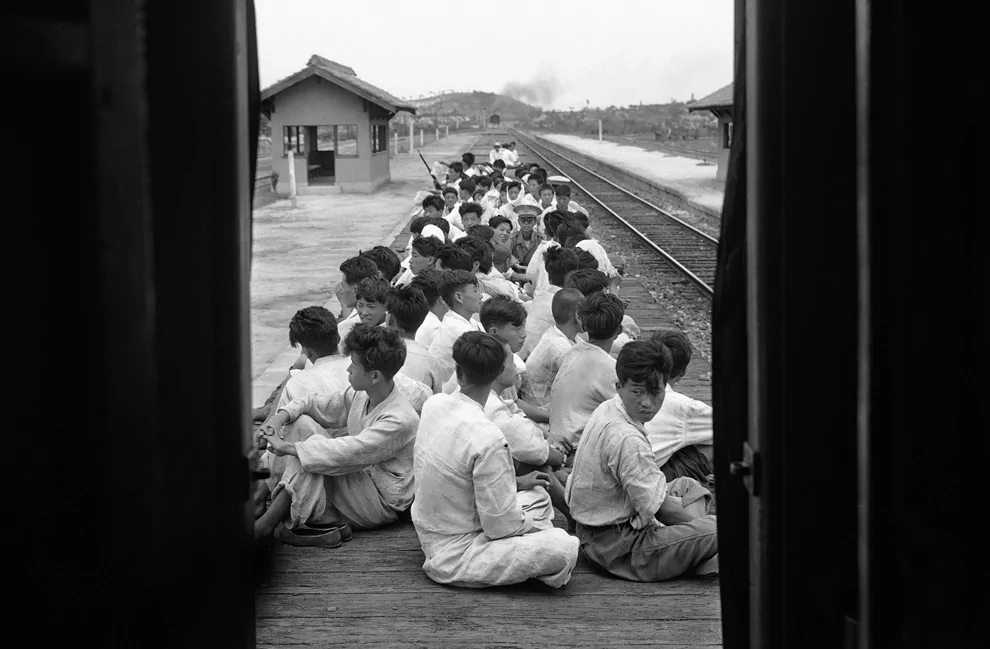
4
These South Korean recruits, sitting flat car for transfer to a training center, are heading for the army and the war against the North Korean invaders. They were given a flag-waving, band-playing send-off on July 17, 1950. (AP Photo) #
1950年7月17日,图中的南韩应征者坐着平板车前去训练营,准备加入对抗北朝鲜的战斗中。他们离别时,人们曾摇旗奏乐夹道相送。(美联社照片)

5
A Bell evacuation helicopter of Marine Observation Squadron 6, carrying wounded Marines from the front lines, lands at "A" Medical Company of the First Marine Division in 1950. Naval corpsmen stand by with stretcher to unload the wounded men from helicopter "pods" and rush them to the operating and hospital tents in the background. (U.S. Department of Defense/TSGT. Charles B. Tyler) #
1950年,一架海洋观察6中队的BELL直升机载着伤员,降落在第一陆战师的医务连附近。机旁手抬担架的是海军团的军人,他们赶来将伤员从直升飞机转移到手术台上和旁边的医疗帐篷中。(美国国防部/ 技术军士TSGT. Charles B. Tyler)
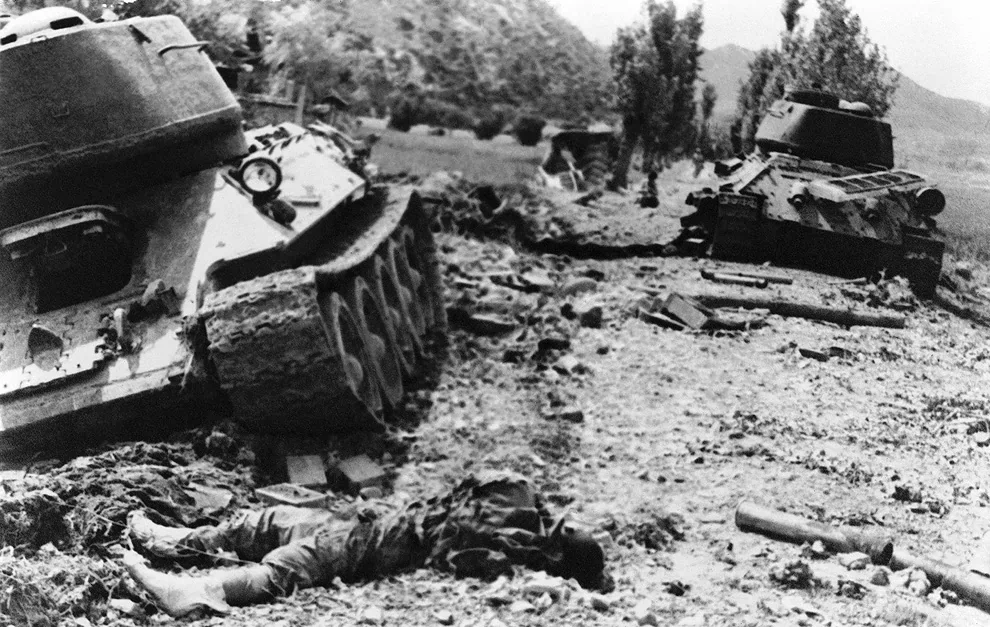
6
A North Korean tankman lies dead on ground (lower left) amid knocked-out tanks on August 13, 1950 in Indong, Korea, North of Waegwan, after South Korean attack. (AP Photo) #
1950年8月13日,在北倭馆的仁同(Indong, Korea, North of Waegwan),南韩攻击后,一片惨败的坦克旁躺着阵亡的北朝战士。(美联社照片)
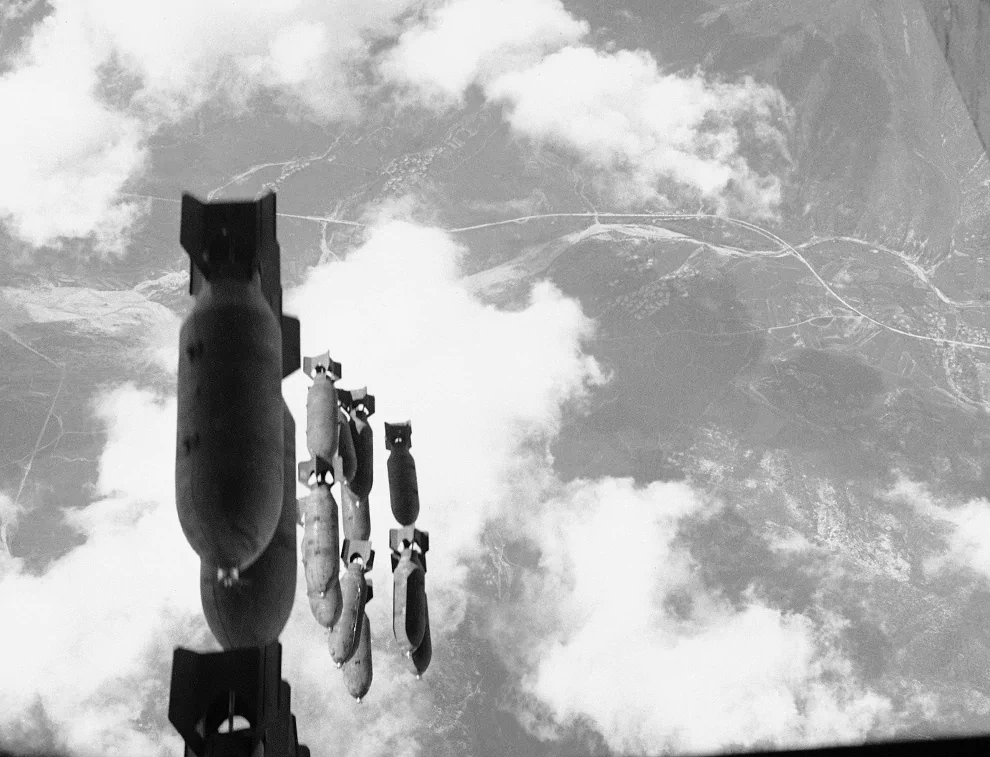
7
A salvo of 500-pound bombs leave the bomb bay of a B-29 headed for communist-controlled territory below. The first bombs from the first squadron over a 21 sq. mile area west of the Naktong River, South Korea on August 16, 1950 where North Korean troops were believed massing for an all-out assault on the American lines. 98 B-29's dropped more than 850 tons of bombs on the area. (AP Photo) #
1950年8月16日,重达500磅的炸弹离开B-29的弹仓,前往苏联占据的领土。头一个中队投下的第一批炸弹覆盖了南韩洛东江以西21平方哩的面积。据称北朝军队驻扎此处,准备对美发起全面进攻。98架B-29共投下850吨炸弹。(美联社照片)
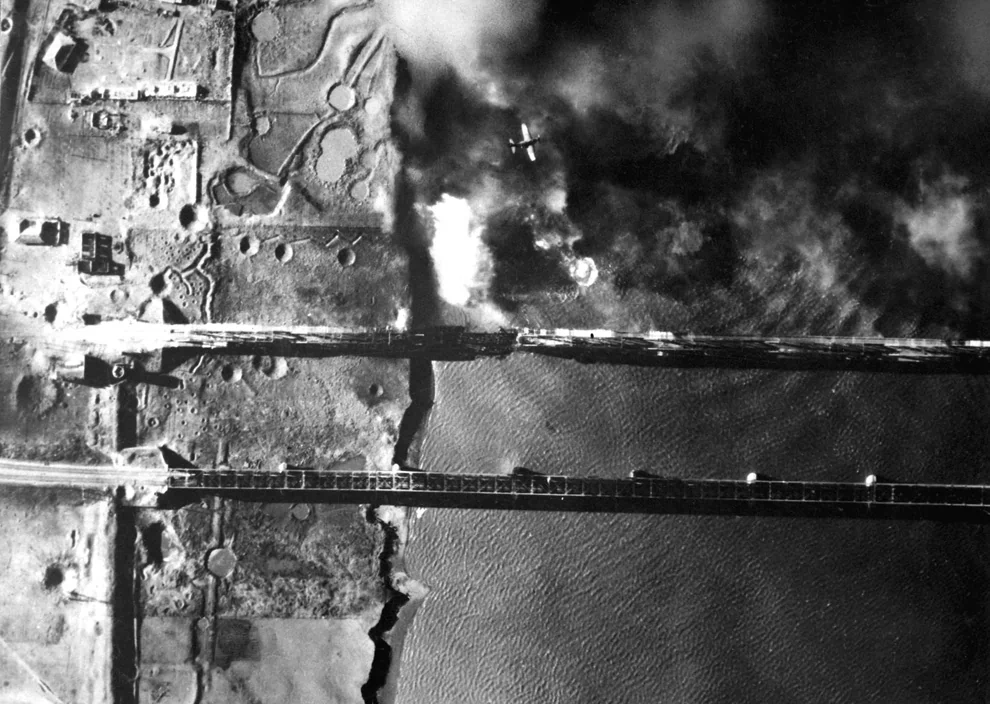
8
Navy AD-3 dive bomber (top center) pulls out of dive after dropping a 2,000 lb. bomb on Korean side of a bridge crossing the Yalu River at Sinuiju, into Manchuria on November 15th, 1950. (U.S. Department of Defense/U.S. Navy) #
1950年11月15日,在新义州---安东(中国城市)鸭绿江的一座桥上空,海军战机俯冲轰炸机AD-3(图中上)在朝鲜一侧投下2000英镑炸弹后拉起。(美国国防部/ 美国海军)
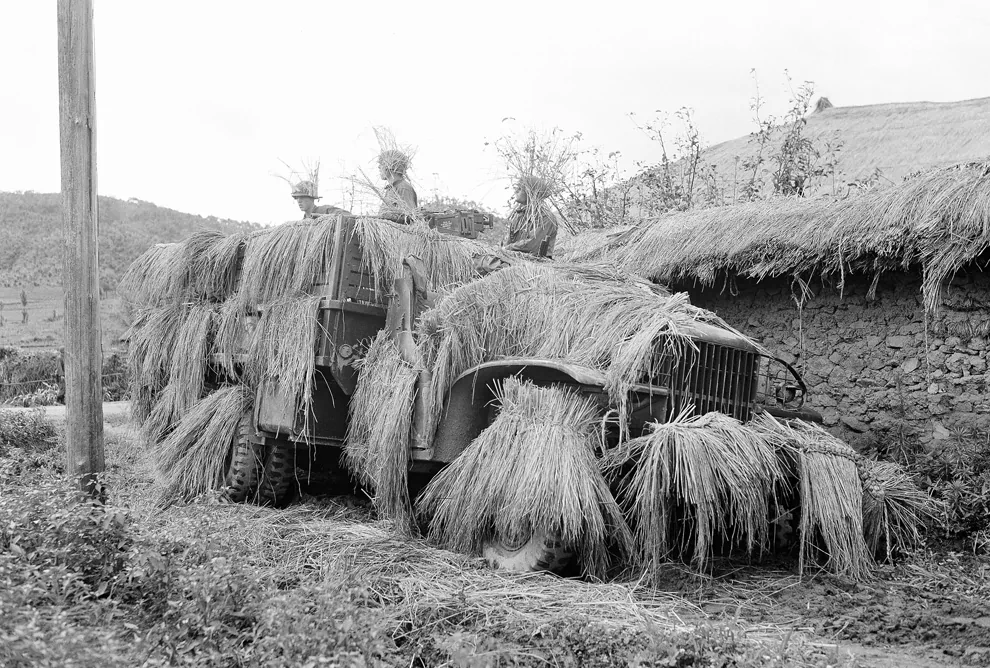
9
This view shows a command post somewhere in South Korea on July 12, 1950 as American soldiers keep on the alert with their straw-covered camouflaged weapons carrier. (AP Photo/Charles P. Gorry) #
1950年7月12日,位于南韩的某指挥所。照片中美国士兵在稻草的掩护下仍保持着警戒状态。(美联社照片/ Charles P. Gorry)
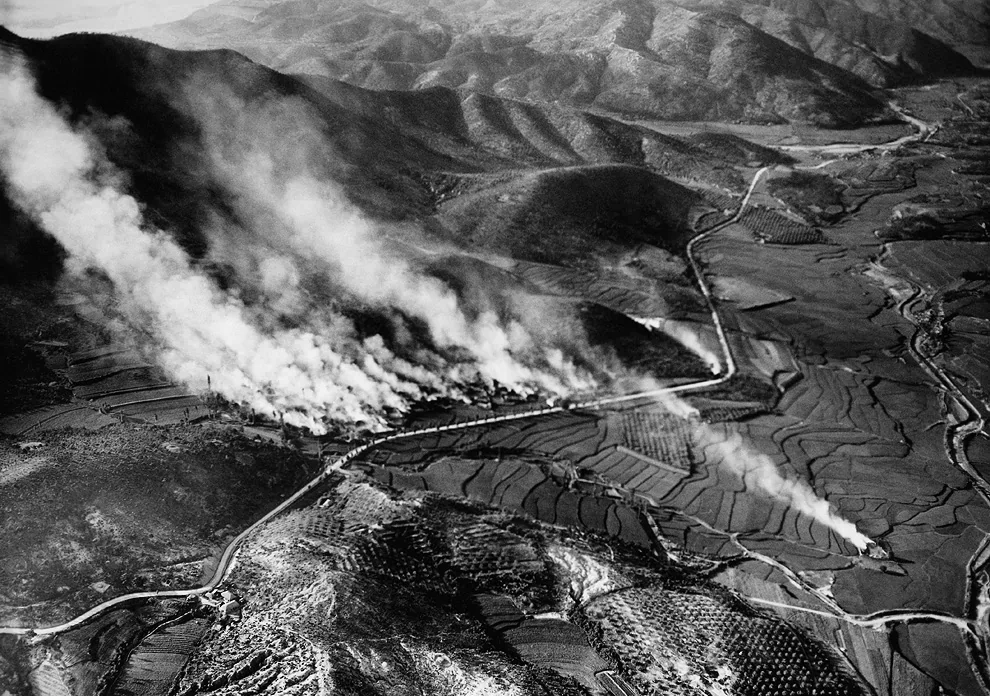
10
Smoke rises from the ruins of the village of Agok the northern region of South Korea in August 1950. (AP Photo/Max Desfor) #
1950年,从南韩北部Agok村庄的废墟上,浓烟升起。(美联社照片/ Max Desfor)
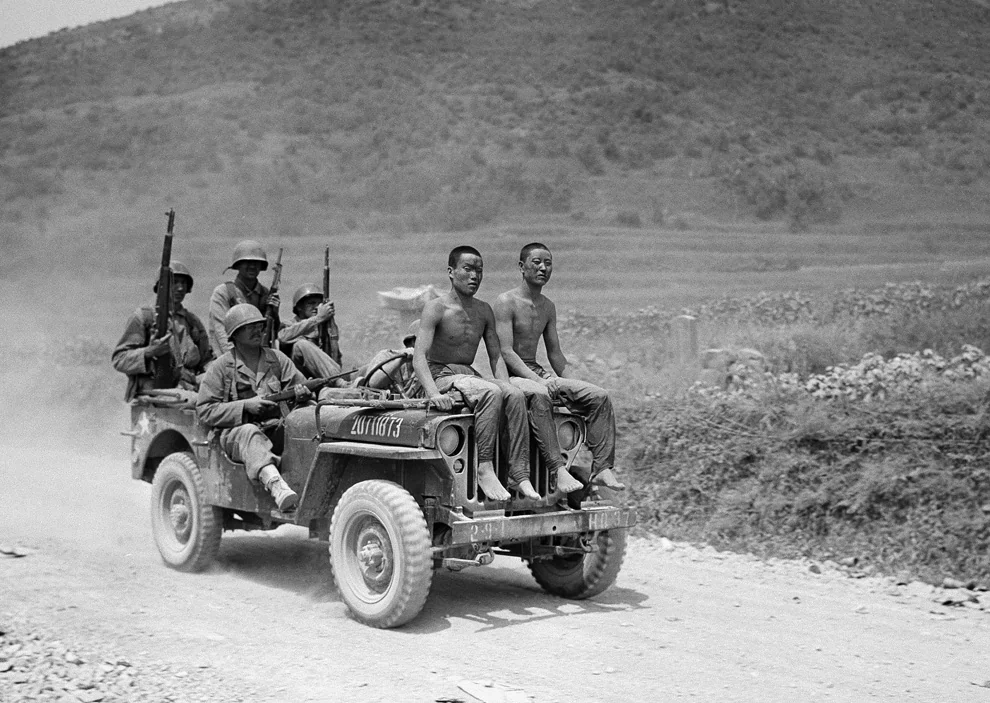
11
Two North Korean prisoners captured during fighting for Yongsan on September 2, 1950 sit on jeep hood under guard of U.S. second division infantrymen as they are taken to the rear in the Naktong River sector of Korea. (AP Photo) #

Warning:
This image contains graphic
or objectionable content
click here to view it.
12
This U.S. Army photograph, once classified "top secret", is one of a series depicting the summary execution of 1,800 South Korean political prisoners by the South Korean military at Taejon, South Korea, over three days in July 1950. Historians and survivors claim South Korean troops executed many civilians behind frontlines as U.N. forces retreated before the North Korean army in mid-1950, on suspicion that they were communist sympathizers and might collaborate with the advancing enemy. (AP Photo/National Archives, Major Abbott/U.S. Army) #
1950年7月份,在韩国大田市1800名政治犯被南韩军队处决的情况。史学家和幸存者们表示,在联合国军队先于北朝鲜在1950年年中撤退时,南韩军队处决了后方很多政治犯,因为怀疑这些人是亲共派并成了自己敌人的同伙。(美联社照片/ 美国国家档案馆,Major Abbott/ 美国陆军)
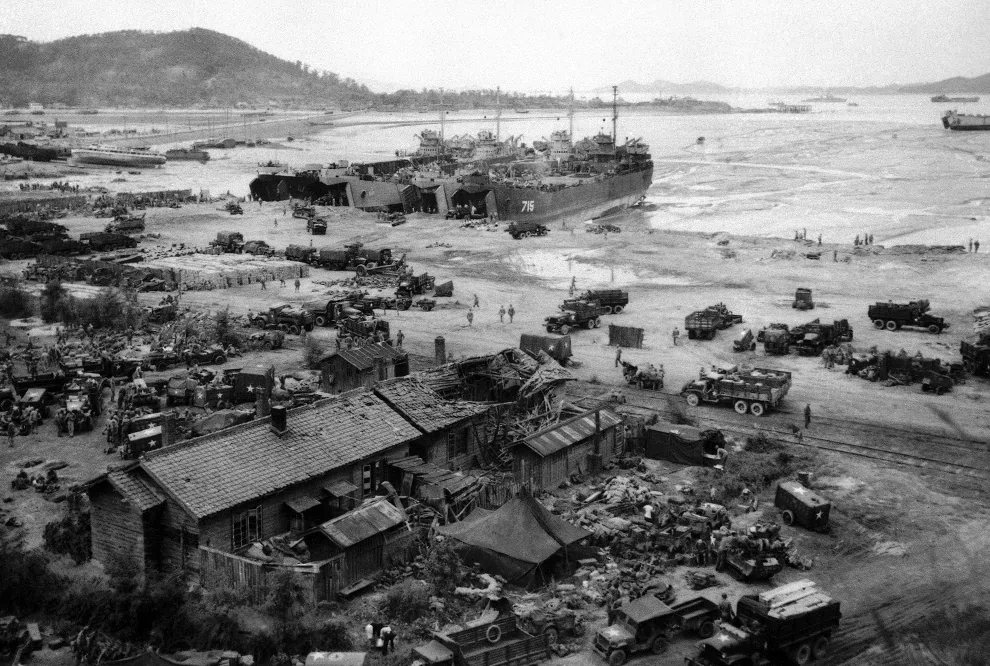
13
Four LST's unload men and equipment on beach in Inchon on Sept. 15, 1950. (AP Photo) #
1950年9月15日,在仁川市的海滩上4辆登陆舰正在卸载士兵和设备。(美联社照片)
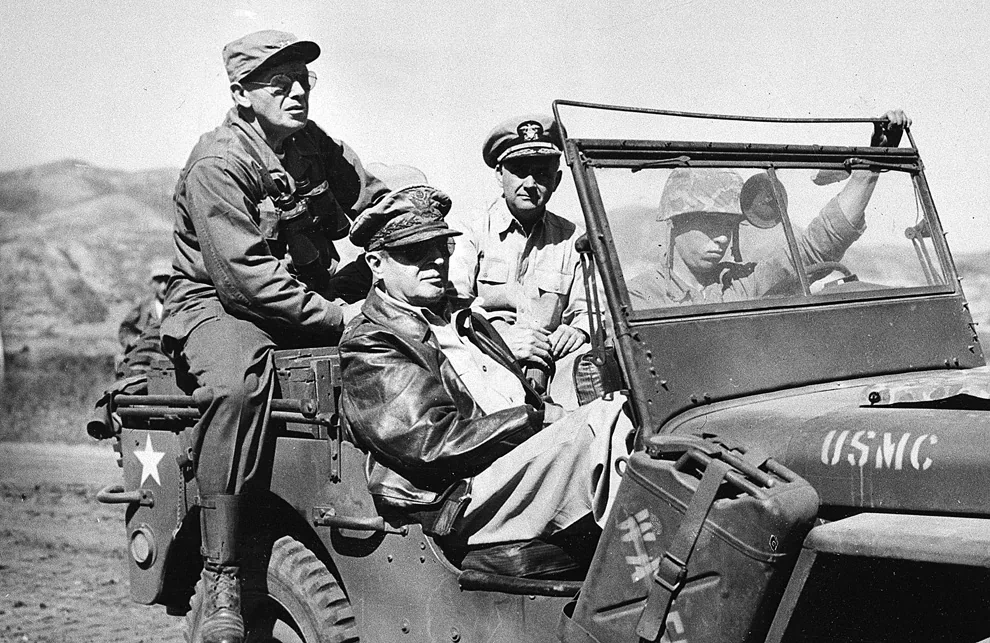
14
General Douglas MacArthur, in passenger seat wearing leather jacket, tours the newly opened Inchon Front in Western Korea on Sept. 19, 1950 during the Korean War. Accompanying him are, Maj. Gen. Edward M. Almond, left, Tenth Corps Commander, and Vice Adm. Arthur D. Struble, Fifth Fleet Commander. (AP Photo/U.S. Army Signal Corps) #
1950年9月19日,在朝鲜半岛西部仁川,麦克阿瑟将军身着皮衣,巡视新拉起的战线。陪同他的是第十军团司令、少将Edward M. Almond(图左)、第五舰队司令、中将. Arthur D. Struble。 (美联社/ 美军录用通信兵)
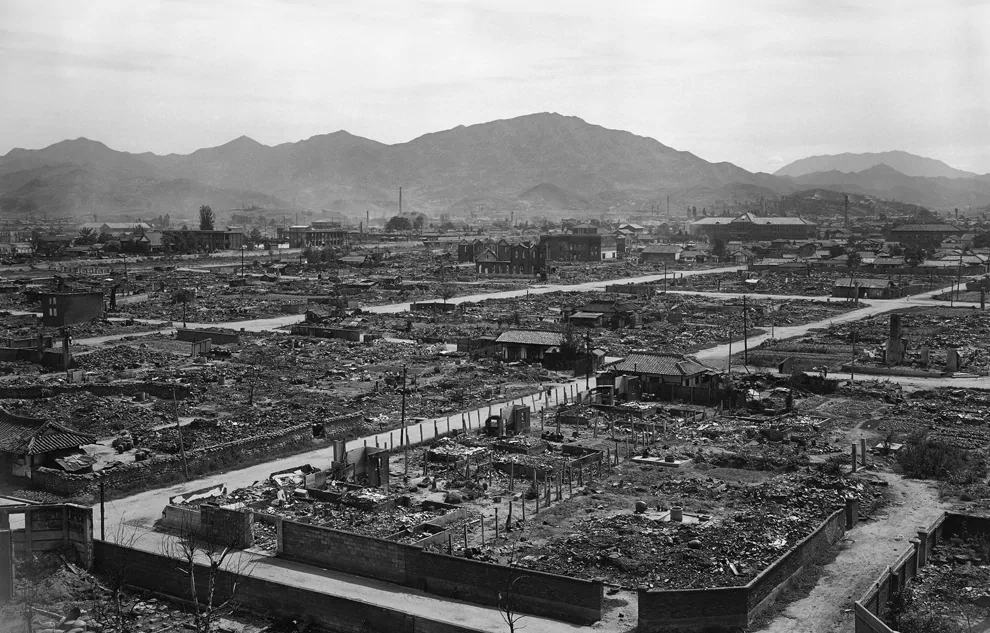
15
General views of burned city of Taejon on Sept. 30, 1950. (AP Photo/Jim Pringle) #
1950年9月30日,韩国大田,灰烬之城鸟瞰。(美联社/ Jim Pringle)
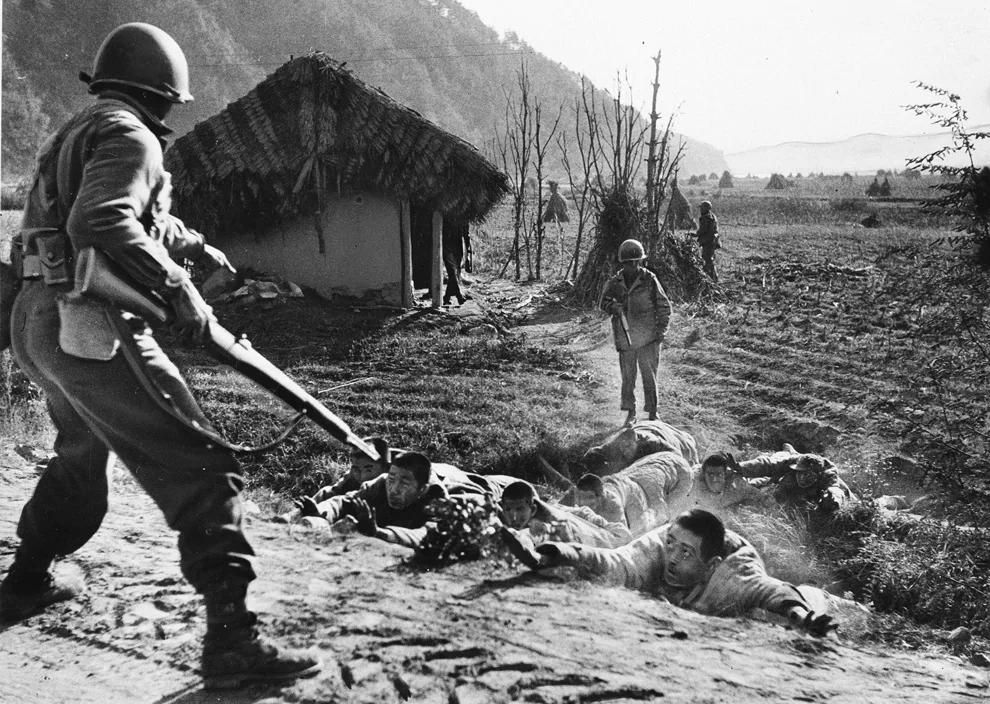
16
Prisoners are flushed out by a U.S. patrol operating in North Korea south of Kusong, Nov. 16, 1950. This is a Life Magazine Photo by Hank Walker. (AP Photo/Hank Walker) #
1950年11月6日,在北朝鲜龟城南部,美国巡逻兵将一批俘虏拖走。本照片由《生活》杂志的Hank Walker拍摄。(美联社照片/ Hank Walker)
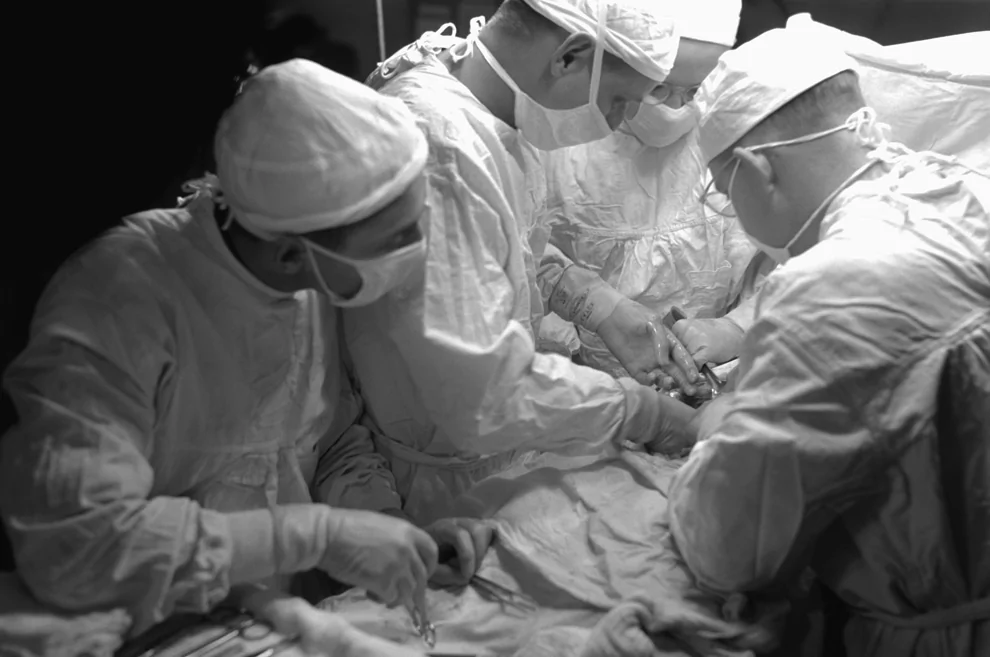
17
Doctors operate on a Marine wounded in Korean fighting on June 25th, 1950. (U.S. Department of Defense/TSGT. Robert H. Mosier) #
1950年6月25日,美国军医们为在朝鲜战场上受伤的海军陆战队士兵做手术。(美国国防部/ 上士Robert H. Mosier)
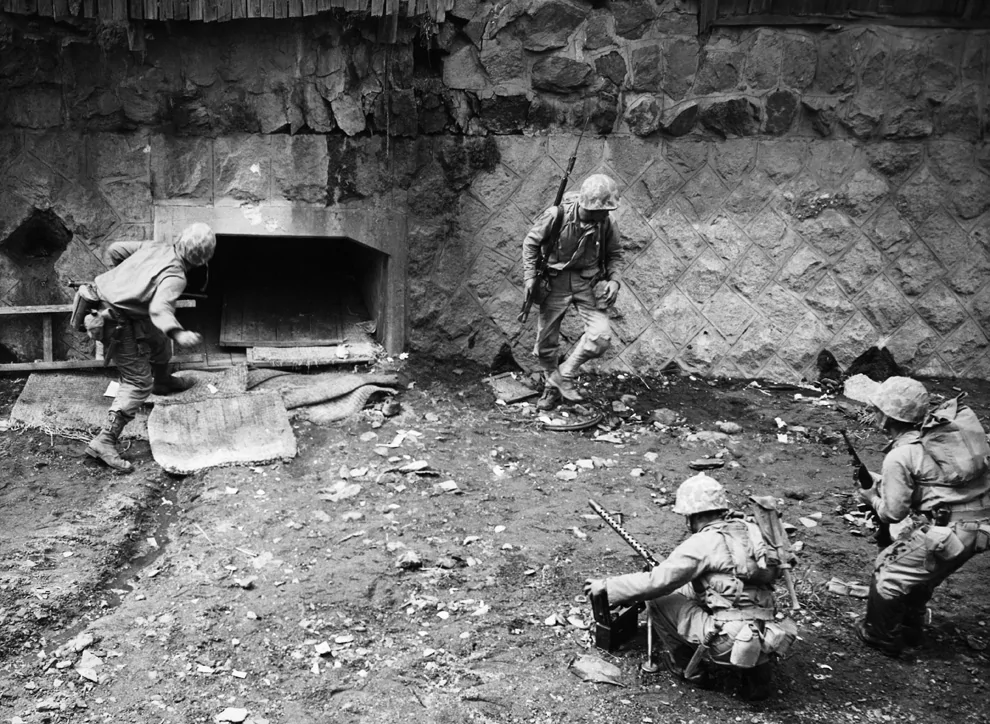
18
After civilians reported that North Koreans had taken cover inside, a U.S. Marine throws a grenade into a Seoul tunnel, in September 1950. A machine gunner and rifleman cover the cave entrance. (AP Photo/Max Desfor) #
1950年9月,汉城。通过市民得知隧道被北朝军队占领后,美国兵投进去一颗手榴弹。机枪手和步枪手瞄准了洞穴入口。(美联社照片/ Max Desfor)
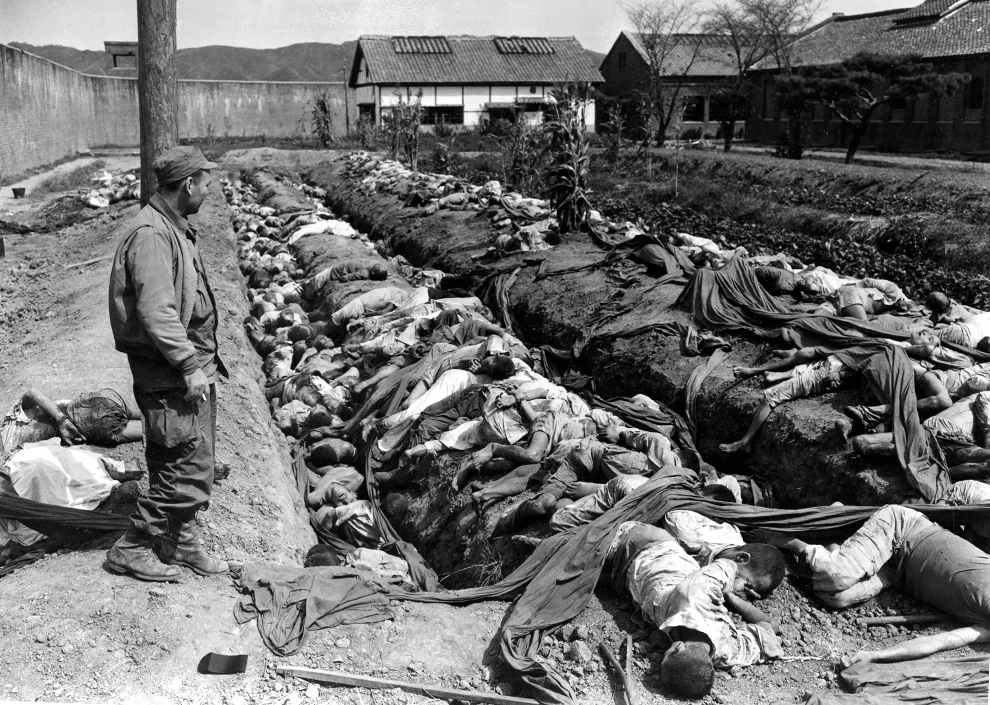
Warning:
This image contains graphic
or objectionable content
click here to view it.
19
Bodies of some 400 Korean civilians lie in and around trenches in Taejon's prison yard during the Korean War in Sept. 1950. The victims were bound and slain by retreating Communist forces before the 24th U.S. Division troops recaptured the city Sept. 28. Witnesses said that the prisoners were forced to dig their own trench graves before the slaughter. Looking on, at left, is Gordon Gammack, war correspondent of the Des Moines Register and Tribune. (AP Photo/James Pringle) #
1950年9月,在韩国大田市监狱内一条壕沟里,横着约400具韩国人的尸体。在美国军队24号重新拿下大田时之前,撤退中的北朝军队囚禁并杀害了这些人。目击者说,囚犯们在死前要自掘坟墓。照片中左边的是《狄盟注册报》(the Des Moines Register and Tribune)的战地记者Gordon Gammack。(美联社照片/ James Pringle)
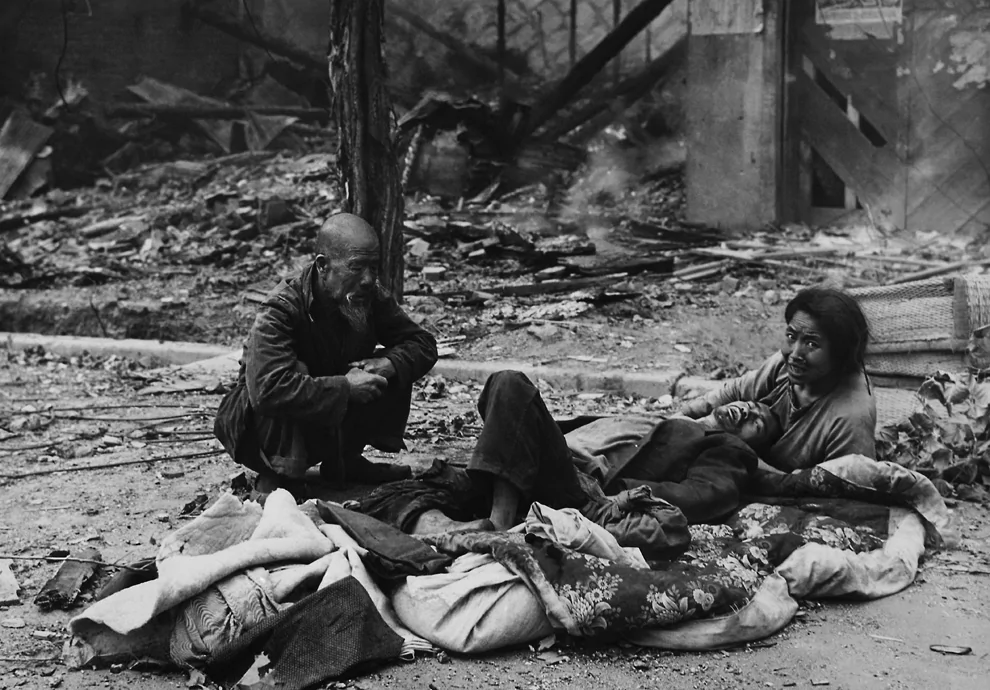
20
Koreans huddle in the street amid rubble and debris after fighting in Seoul, September 1950. (AP Photo/Max Desfor) #
1950年9月,汉城,民众蜷身于战事后的一片废墟中。(美联社照片/ Max Desfor)
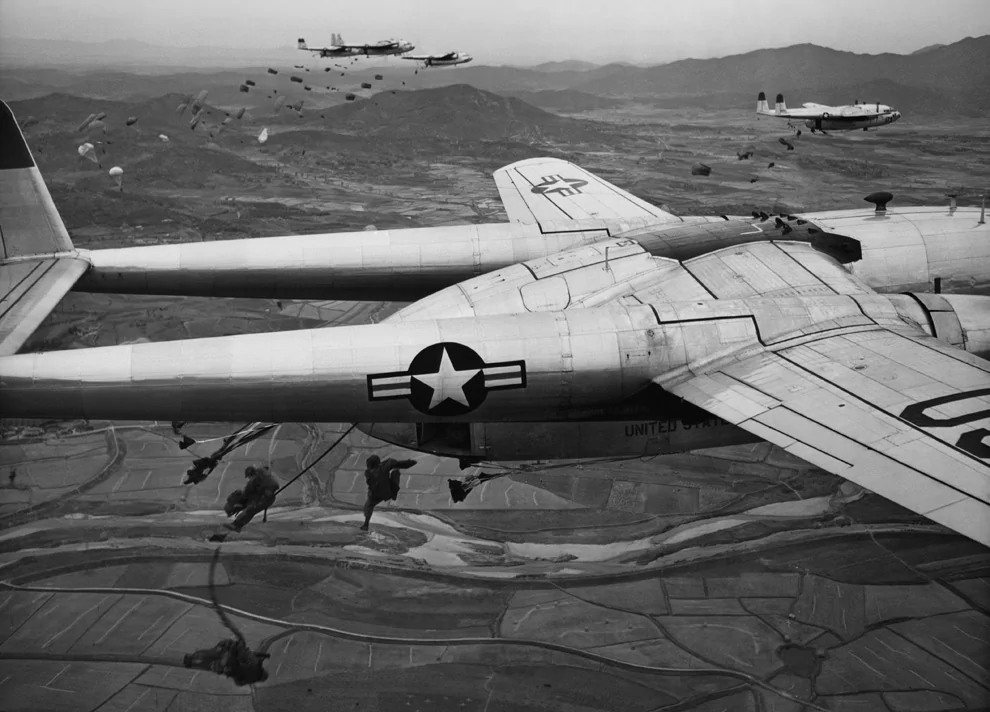
21
Paratroopers drop from U.S. Air Force C-119 transport planes during an operation over an undisclosed location in Korea, in October 1950. (AP Photo/Max Desfor) #
1950年10月,执行一项针对保密地区任务的美国伞兵从空军C-119运输机跳下。(美联社照片/ Max Desfor)
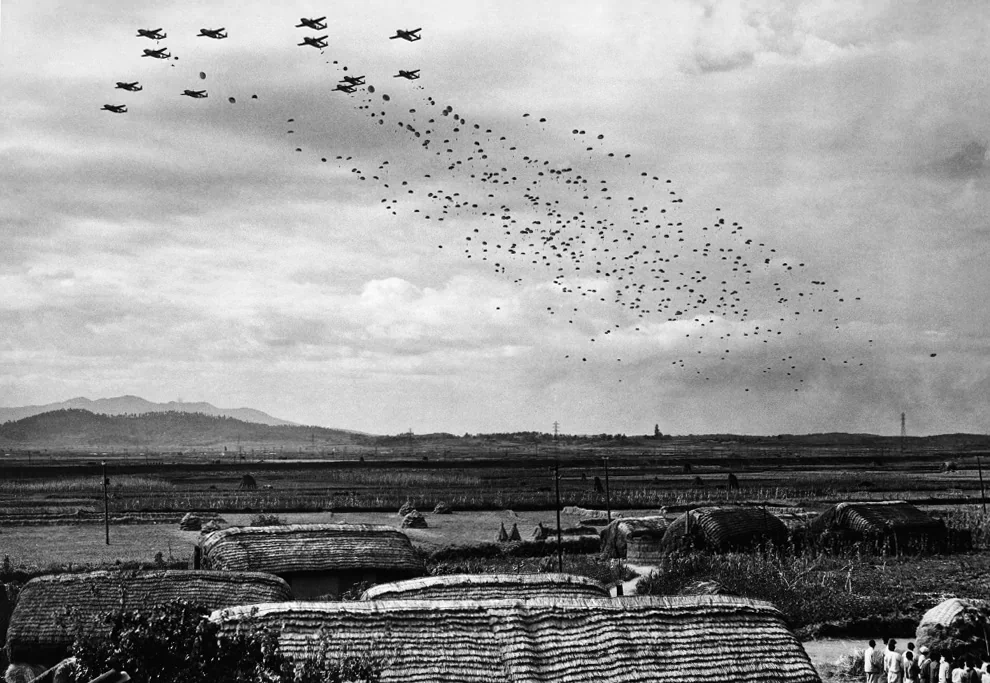
22
Paratroopers of the United Nations forces jump from aircraft near the North Korean towns of Sukchon and Sunchon, about Oct. 20, 1950. (AP Photo/Max Desfor) #
1950年10月20日左右,在北韩小镇肃川和顺天(Sukchon and Sunchon)附近,联合国军伞兵从天而降。(美联社照片/ Max Desfor)
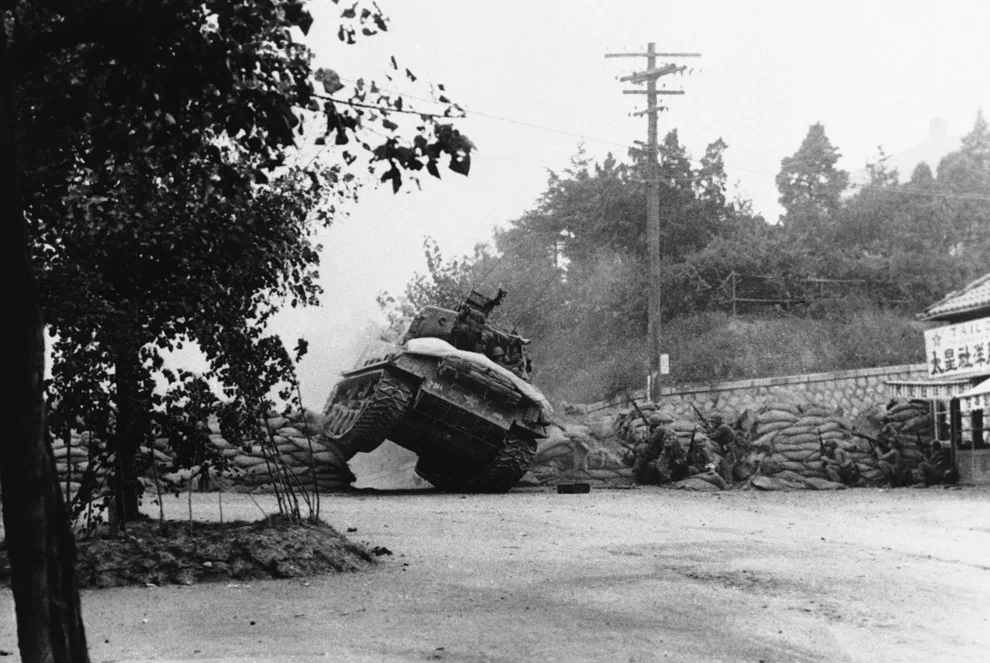
23
An American tank crashes roughshod through an enemy roadblock near Seoul, South Korea, Oct. 7, 1950, as 7th Division infantrymen prepare to exploit the breakthrough and put an end to enemy sniper fire in this sector of the Korean front. (AP Photo) #
1950年10月7日,在韩国汉城附近,美军坦克碾过敌军的路障。此时第7步兵师正要乘胜追击、彻底摧毁敌方的狙击火力。(美联社照片)
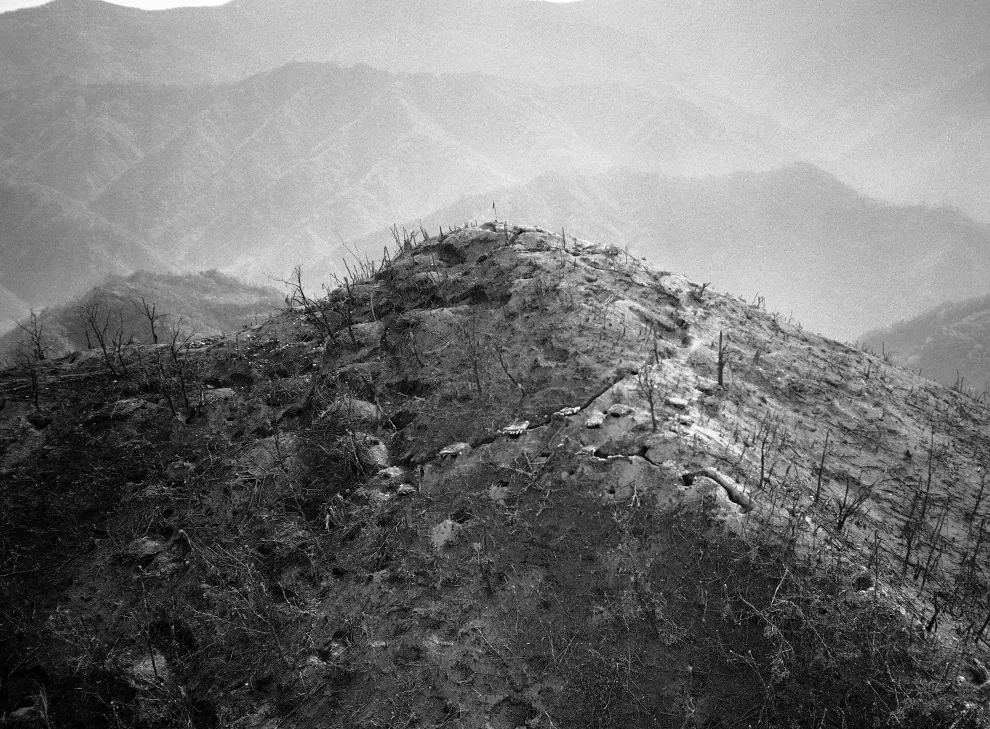
24
Trees stripped by artillery and aerial bombardment stand like match sticks in this air view of hill 931 on Oct. 22, 1950, one of the main peaks which dominated Heartbreak Ridge in Korea. The complex system of communist trenches and bunkers are visible. This hill was taken twice by U.N. forces, the last time on October 6 by elements of the 23rd U.S. Regiment and a French Battalion. (AP Photo/GS) #
1950年10月22日,一轮轮地空轰炸后,931山上的树像一根根直立的火柴棍。这座山头是伤心岭战役中几座重要的山峰之一。北朝军队战壕和碉堡的复杂体系由图可见。美军曾两次占领这座山,后一次是10月6日,协作双方是美军23团和法军某营。(美联社照片/ GS)
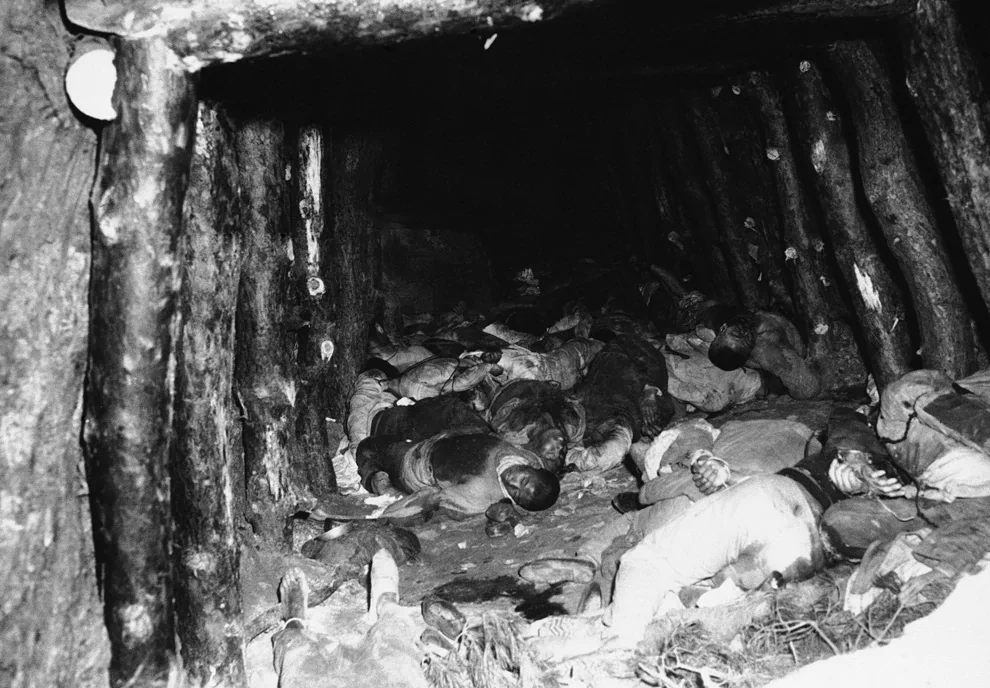
Warning:
This image contains graphic
or objectionable content
click here to view it.
25
The bodies of more than 60 South Korean civilians bludgeoned to death in a mine shaft at Kum Bong San, near Tube-ni, Korea, Oct. 19, 1950. The Army said the victims were slain by Communist led North Korean forces who took them from a prison at Chinnampo. The bodies were discovered by U.N. troops. (AP Photo) #
1950年10月19日,在朝鲜Tube-ni附近Kum Bong San的一口矿井中60多名南韩百姓被活活打死。军方称,对这些从镇南浦监狱中的人下手的是共产主义阵营的北朝军队。这些尸体由联合国军队发现。(美联社照片)
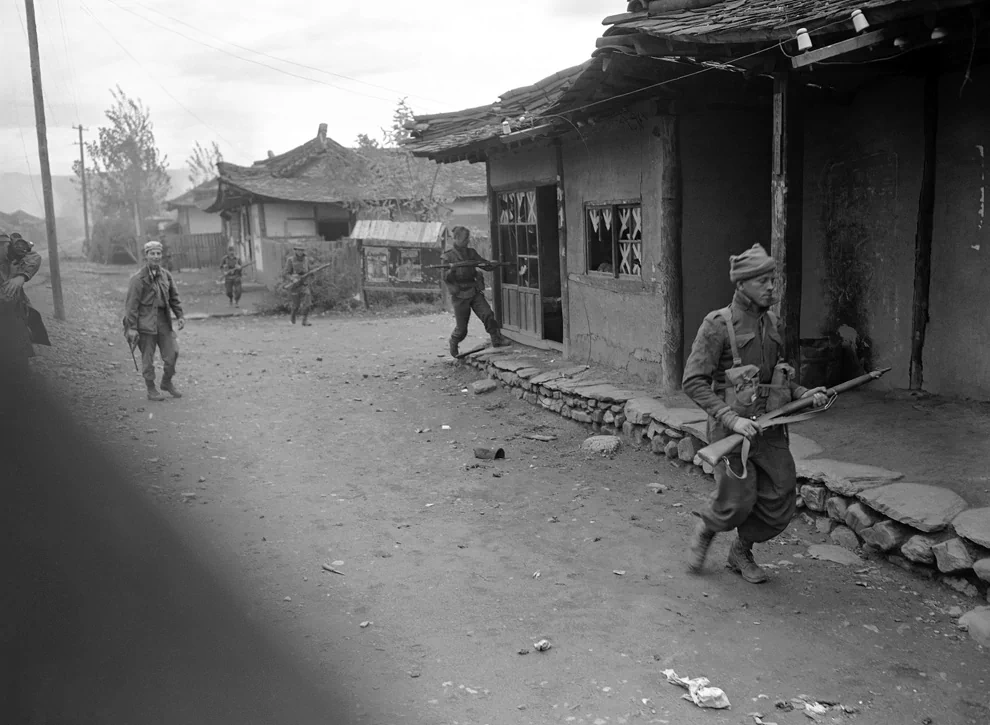
26
British and Australian troops search houses in Hwangju on Oct. 17, 1950 in mopping up operations during the drive toward Pyongyang, Capital of North Korea. (AP Photo/Max Desfor ) #
1950年10月,英国和澳大利亚士兵在韩国黄州搜查房子,他们正在前往北朝首都平壤的扫荡活动中。(美联社照片/ Max Desfor)
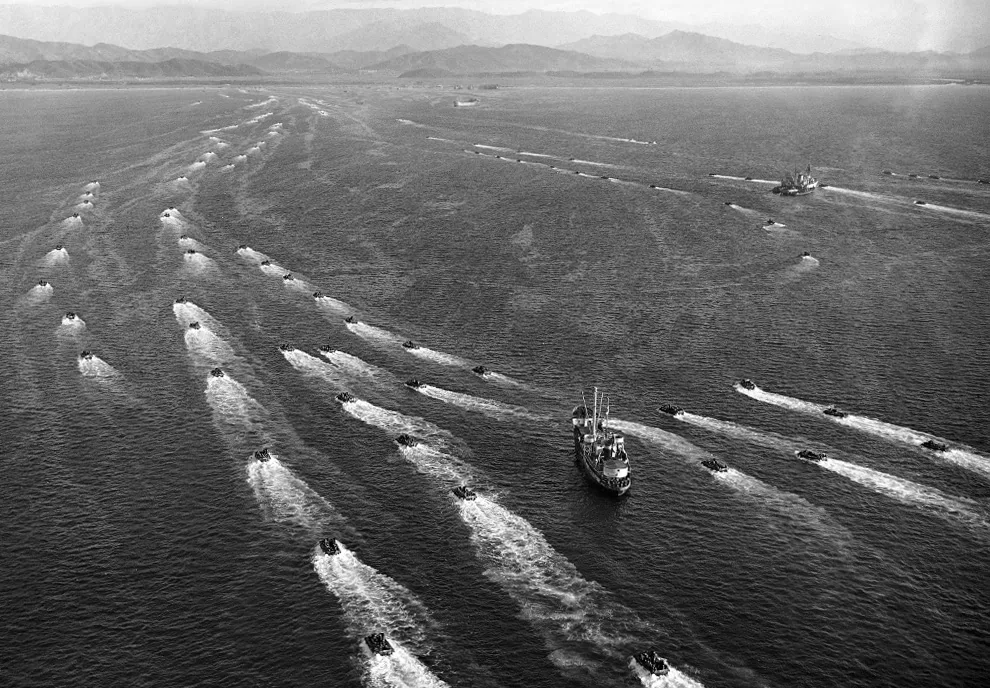
27
Landing boats loaded with U.S. soldiers speed through the mine-infested waters of Wonsan harbor toward the North Korean east coast city on Oct. 26, 1950. About 50,000 U.S. soldiers and Marines hit the beach to bolster Allied forces driving toward the Manchurian border. (AP Photo/Gene Herrick) #
1950年10月26日,满载美国士兵的登陆舰驶过布满水雷的元港(Wonsan harbor)水域,去往北朝的东部沿海城市。约5万名美海陆军士兵登陆,增援向中国东北与北朝接壤地区开进的盟军部队。(美联社/ Gene Herrick )

28
In this Dec. 4, 1950 file photo, residents from Pyongyang, North Korea, and refugees from other areas crawl perilously over shattered girders of the city's bridge, as they flee south across the Taedong River to escape the advance of Chinese Communist troops. (AP Photo/Max Desfor) #
1950年12月4日,为躲避中共军队,平壤居民和其他地区的难民沿着城市大桥的梁上逃往大同江那边的南韩。(美联社照片/ Max Desfor)
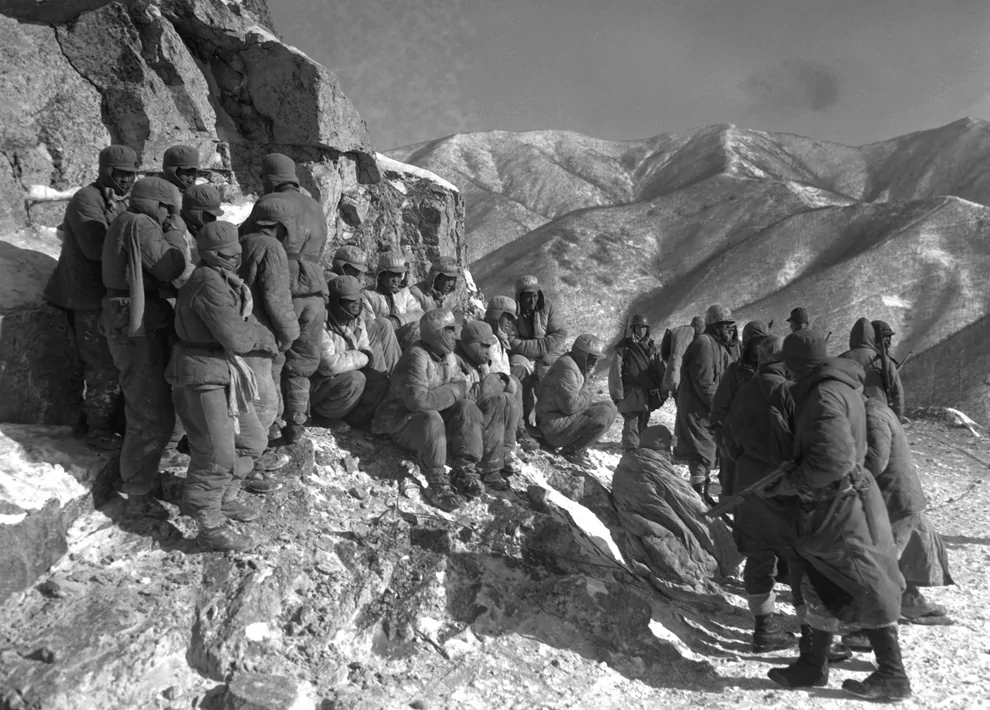
29
Chinese communist troops, wearing tennis sneakers, rags and American footgear, surrender to Charley Company, 7th Marines, south of Koto-ri, on December 9th, 1950. (U.S. Department of Defense/SGT. F.C. Kerr) #
1950年12月9日,在Koto-ri南部,中共士兵穿着网球鞋、美国鞋袜,向美军第7海军陆战队查理连投降。(美国国防部/ 上士 F.C.Kerr)
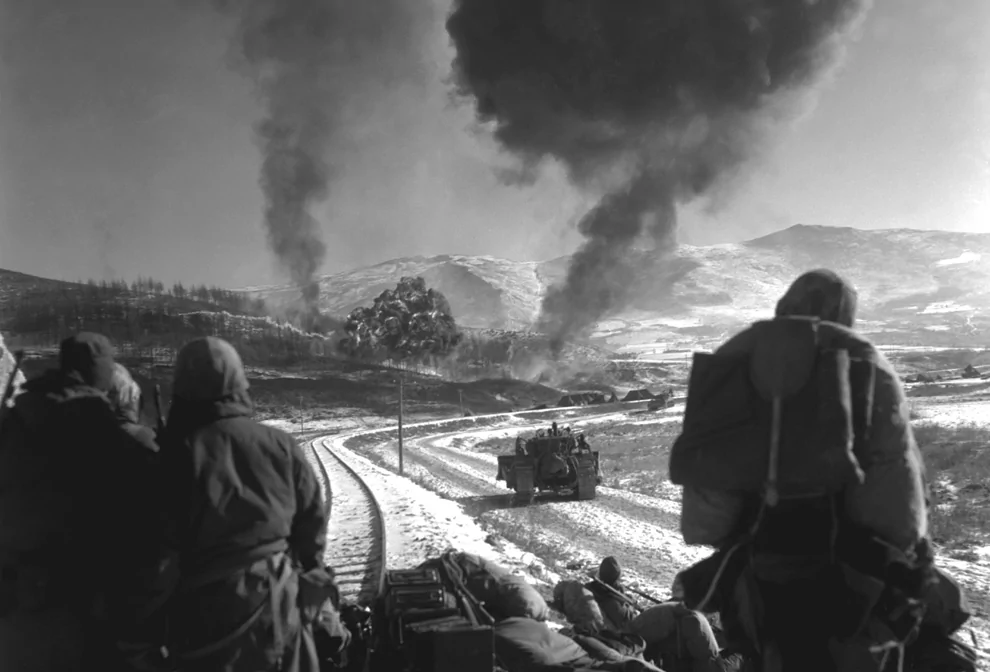
30
Close coordination of the United States Marine air and ground units during recent fighting with Chinese Communists in Korea. United States Marines drive forward after effective close air support of F4U-5 Corsairs on December 26th, 1950. (U.S. Department of Defense/CPL. P. McDonald) #
1950年12月26日,在最近的一场对中共军队作战中,美地空部队密切协调。海军陆战队在F4U-5海盗式战斗机的有效支援后继续将战线向前推进。(美国国防部/ 下士 P. McDonald)
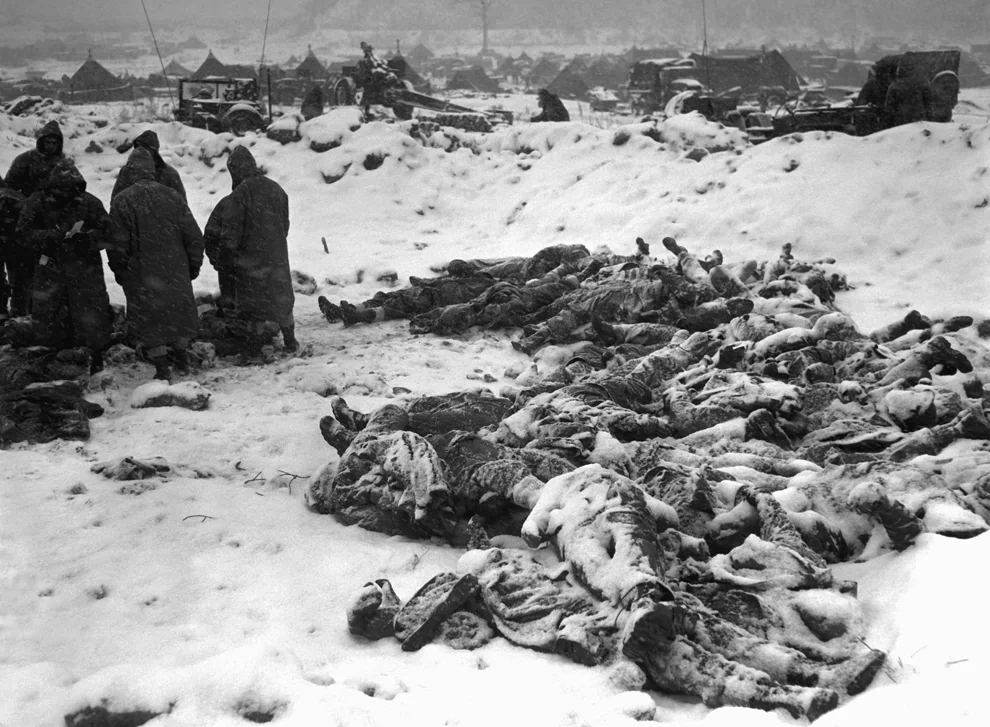
Warning:
This image contains graphic
or objectionable content
click here to view it.
31
Bodies of U.S. Marines, British Royal Marines Soldiers and Republic of Korea troops are gathered for a mass burial at Koto-ri on December 8th, 1950. (U.S. Department of Defense/SGT. F.C. Kerr) #
1950年12月8日,在Koto-ri(?里),美海军陆战队、英国皇家海军陆战队和韩国阵亡士兵运到一起,举行集体葬礼。(美国国防部/ 上士 F.C. Kerr)
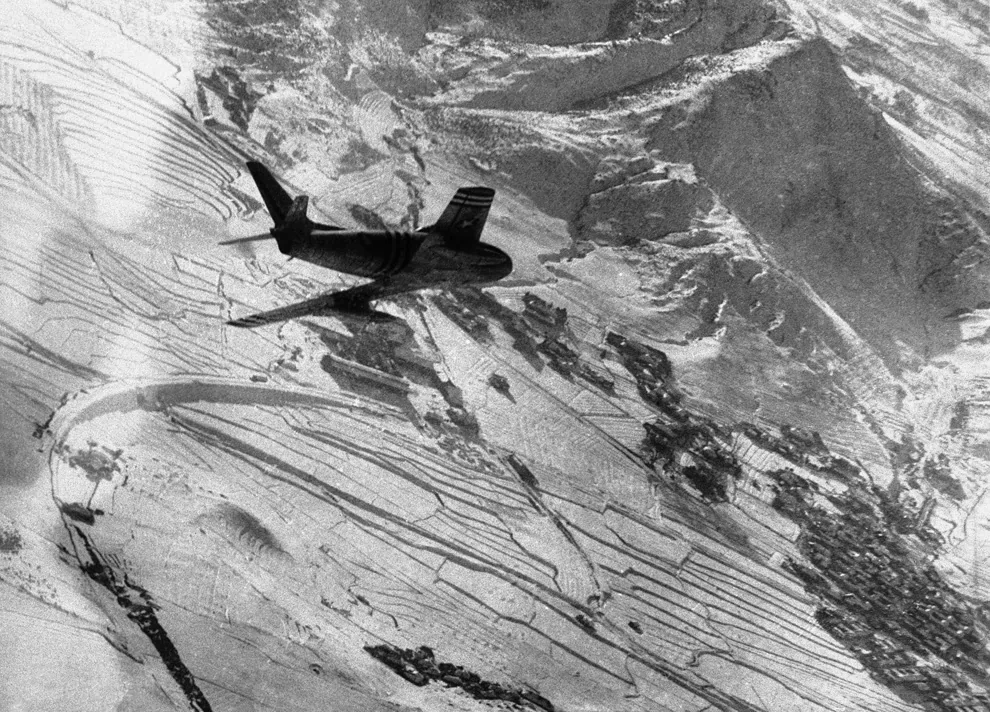
32
An F86 Sabre Jet peels off for an attack on a communist troop and supply concentration in the snow-covered Korean village below on January 28th, 1951. (AP Photo) #
1951年1月28日,一架F86军刀喷气式飞机投下攻击中共军队的炮弹。同时它也在为大雪覆盖的村庄提供物资。(美联社照片)
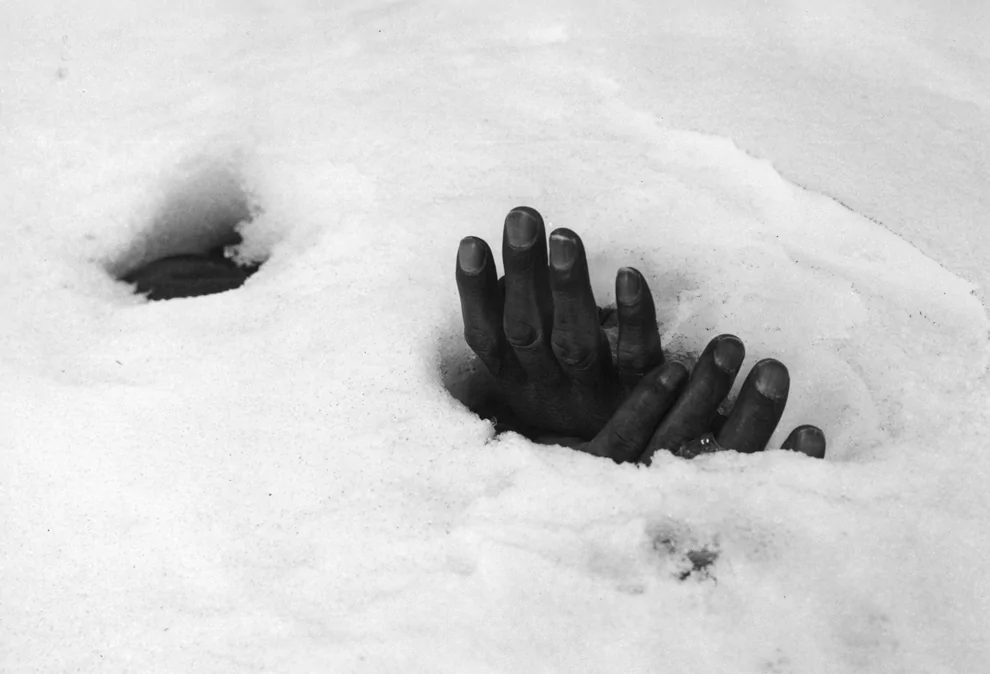
33
A pair of bound hands and a breathing hole in the snow at Yangji, Korea, Jan. 27, 1951 reveal the presence of the body of a Korean civilian shot and left to die by retreating Communists during the Korean War. (AP Photo/Max Desfor) #
1951年1月27日,在朝鲜半岛洋吉(Yangji),被缚的一双手穿过雪地中的透气孔,雪下之人被撤退中的共军击倒,奄奄一息。(美联社/ Max Desfor)

34
Canadian riflemen catch up on the hometown news while waiting for orders to move up against the Chinese communist forces on the Korean front on Feb. 29, 1951. (AP Photo) #
1951年2月29日,加拿大的步枪手们一边阅读家乡的报纸一边等着前进的指令,他们将在朝鲜战场上迎战中共的军队。(美联社照片)
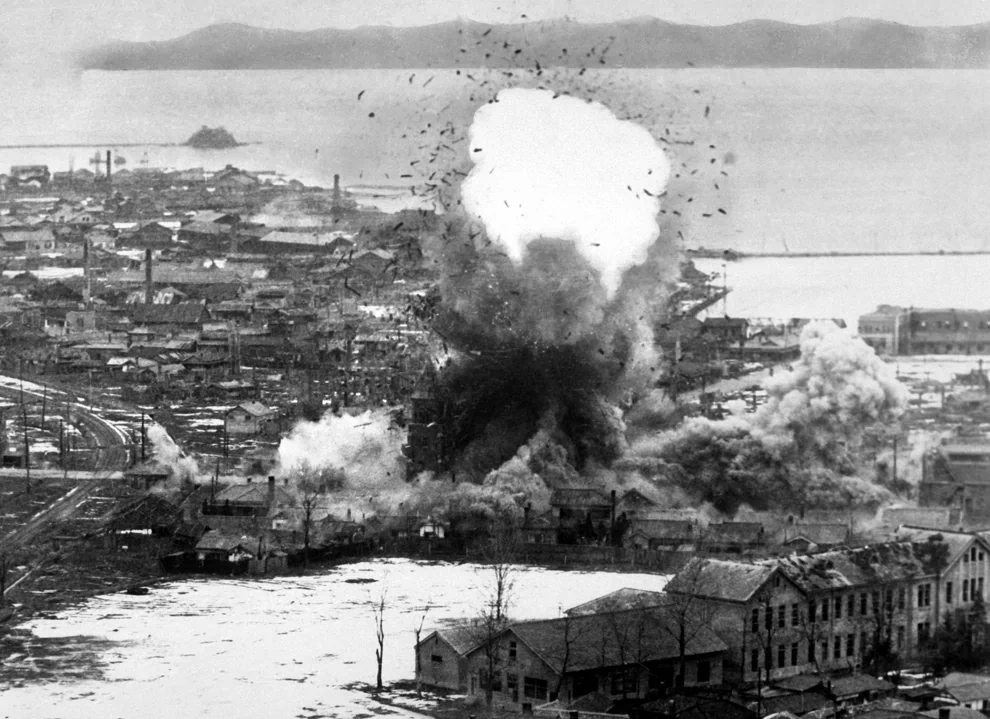
35
Supply warehouses and dock facilities at this important east coast port feel the destructive weight of bombs dropped from Fifth Air Force's B-26 Invader light bombers, Wonsan, North Korea in 1951. (U.S. Department of Defense/USIA) #
1951年在北朝的重要东部港口城市元山,地面的货物仓库和码头设施遭到美第5军B-26轻型轰炸机的毁灭性攻击。(美国国防部/ 美国新闻署)
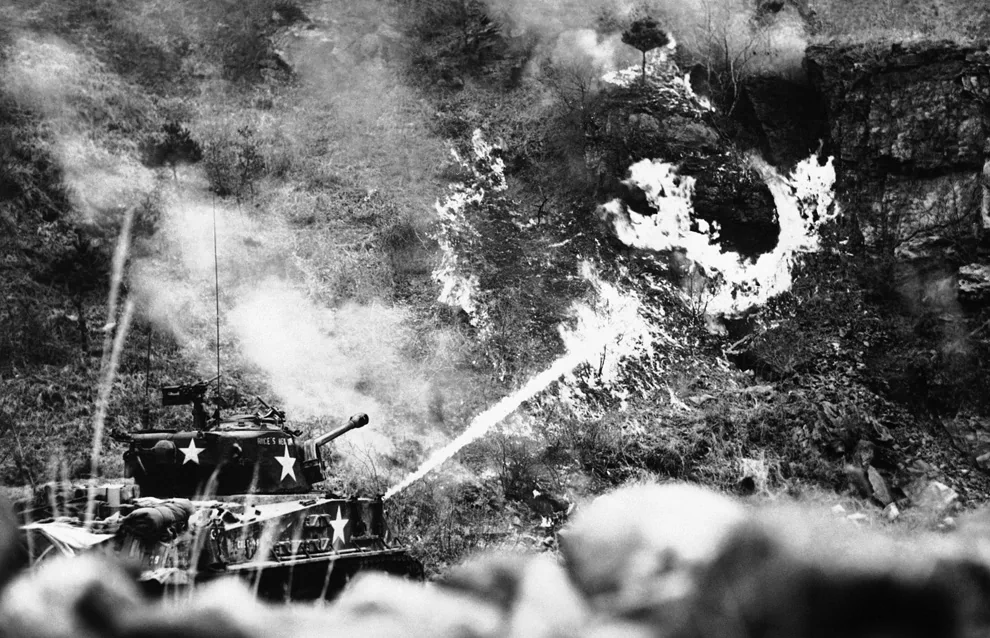
36
A 25th Division tank uses a flame thrower on an enemy pillbox deeply emplaced in a hillside near Korea's Han River front on March 30, 1951. (AP Photo) #
1951年3月30日,美军第25师的坦克用喷火器攻击深藏于朝鲜汉江旁山中的敌方碉堡。(美联社照片)
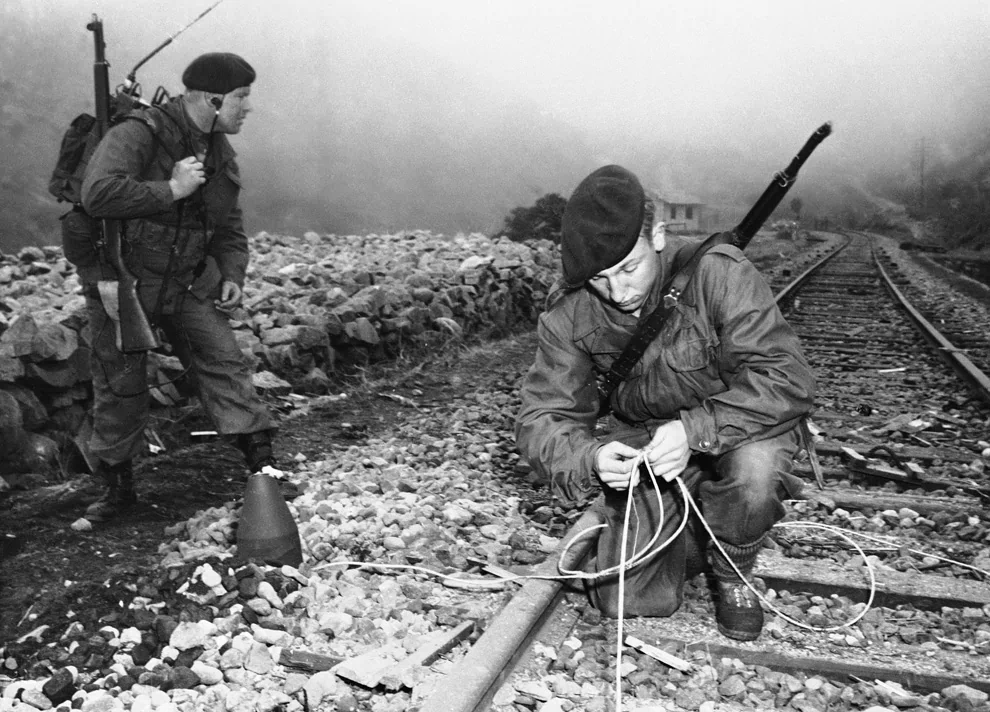
37
British Royal Marines Commandos, put ashore by a U.S. naval vessel deep in the heart of North Korea, plant demolition charges along an enemy rail track on April 13, 1951 near Songjin, South Korea during a daring daylight raid. About 100 yards of the vital Chinese Communist rail line were destroyed within a few miles of two enemy divisions. (AP Photo) #
1951年4月13日,由美国海军帮助在北朝鲜腹地登陆的英国皇家海军陆战队突击队,在金策(Songjin)附近沿敌方铁轨布下破坏性炸药包。中共两个师驻扎地之间约100码的重要铁路被破坏。(美联社照片)
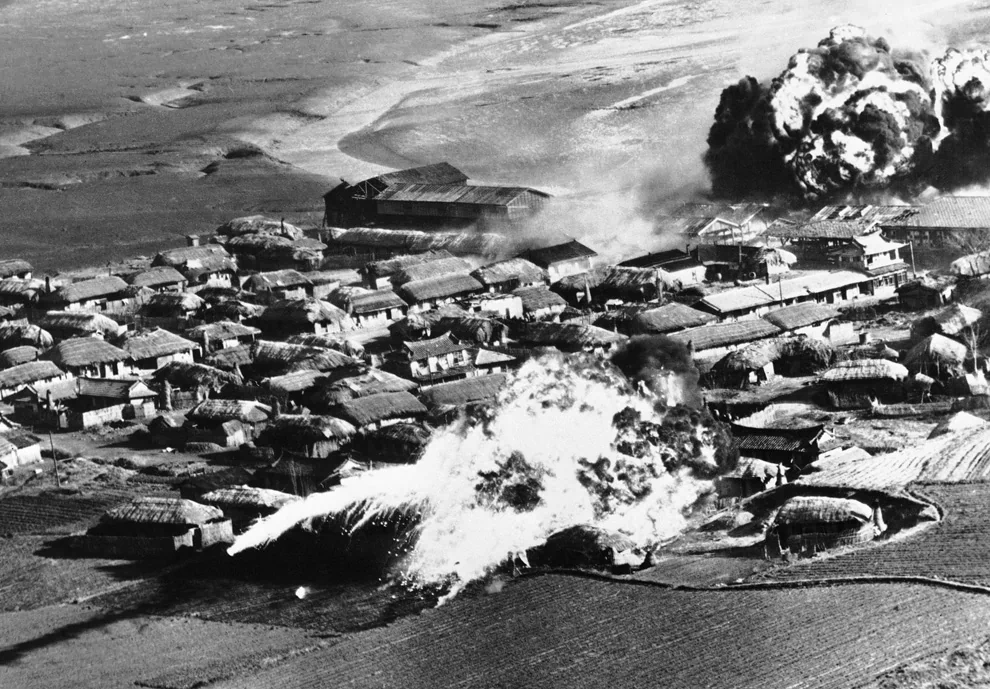
38
Thatched huts go up in flames after B-26 bombers unload napalm bombs on an enemy supply collection point near Hanchon in North Korea on May 10, 1951. (AP Photo) #
1951年5月10日,在北朝鲜的韩川一个补给站附近,B-26轰炸机的一轮凝固汽油弹轰炸后,地面成片茅草屋纷纷着火(美联社照片)
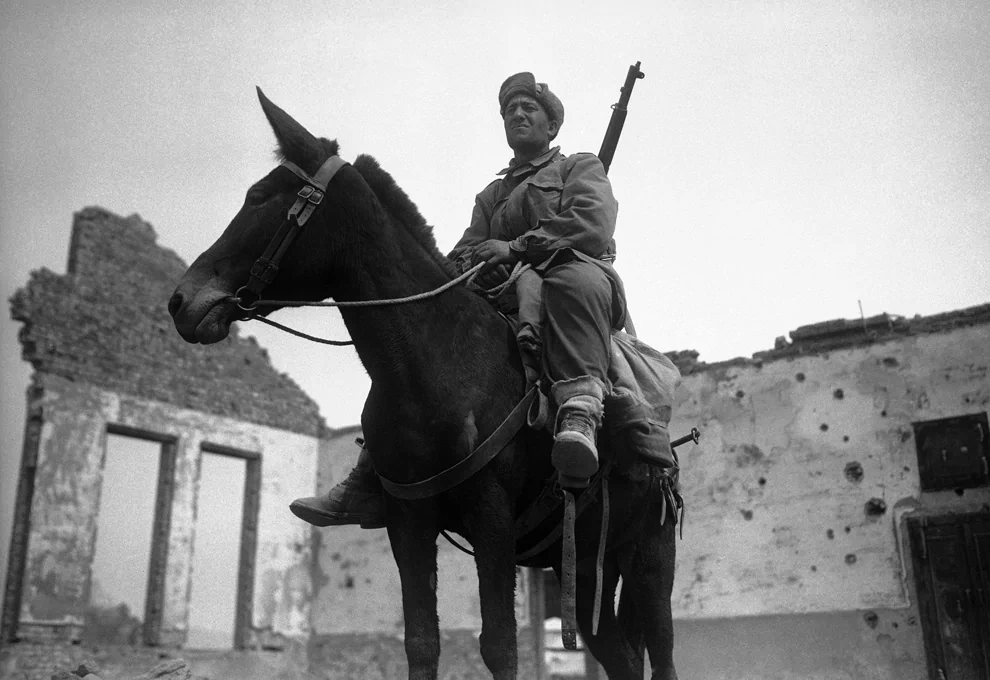
39
Wearied by long marches on foot, a Turkish U.N. solider sits astride a mule he took from an enemy soldier in Korea on May 5, 1951. He ambushed the advancing Chinese and grabbed the mule for use in directing stragglers to the rear in ruins of Uijongbu during the recent communist offensive. (AP Photo/Robert Schutz) #
1951年5月5日,一名联合国的土耳其战士长途跋涉后坐在一匹从敌军那里缴来的骡子上。在中共军队前进途中,他伏击俘获了这头骡子,引导在刚过去的中共军攻击后掉队的己方士兵们转移到废墟的后面。(美联社照片/ Robert Schutz)
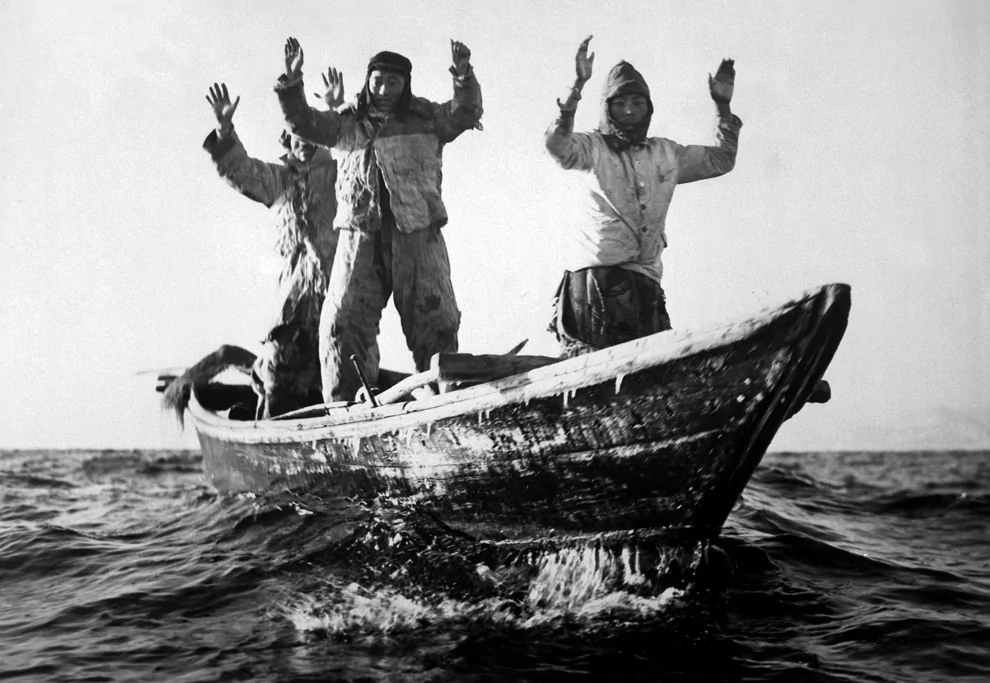
40
Three Korean Communists in a fishing boat are captured by the USS Manchester off the coast of Korea. May 10, 1951. (U.S. Department of Defense/U.S. Navy) #
1951年5月10日,渔船上的3名朝鲜共产党员成了曼彻斯特驱逐舰的俘虏。(美国国防部/ 美国海军)
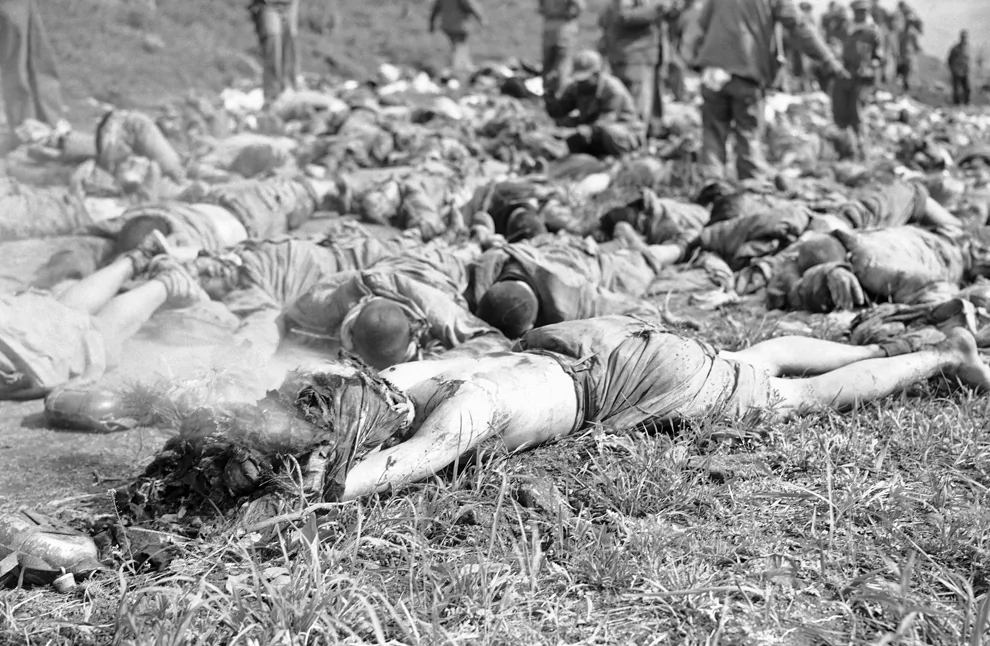
Warning:
This image contains graphic
or objectionable content
click here to view it.
41
A dead Chinese soldier, his burned uniform still smoking, lies with bodies of his comrades at a collection point near Chunchon on May 17, 1951 after allied forces had stemmed the major enemy attack near the town on Korea's central front. (AP Photo/ENJ) #
1951年5月17日,在春川附近的据点,联军在朝鲜中部的战线阻止了一次敌军进攻。这次战斗后,一位刚死去的中共军人衣衫仍在燃烧,旁边是他的同志们的尸体。(美联社照片/ ENJ)
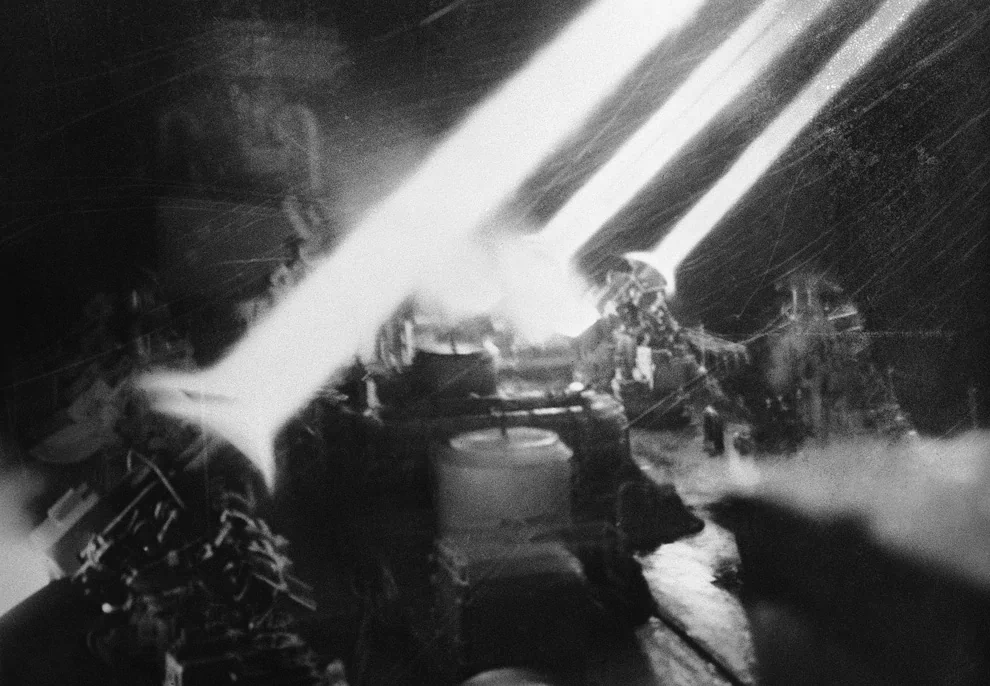
42
Columns of light stab the night as U.S. rockets thunder toward Communist-held targets in Wonsan, Korean port city on July 1, 1951. The fire trails brilliantly lit the ship and could be followed by sight as they struck their targets. (AP Photo/DOD) #
1951年7月1日,光柱刺穿黑夜,美军火箭朝向共军在朝鲜港口城市元山的一处目标。火箭的尾迹正好照亮船只,它们在袭击目标时可以用肉眼观察到。(美联社照片/ 美国国防部)
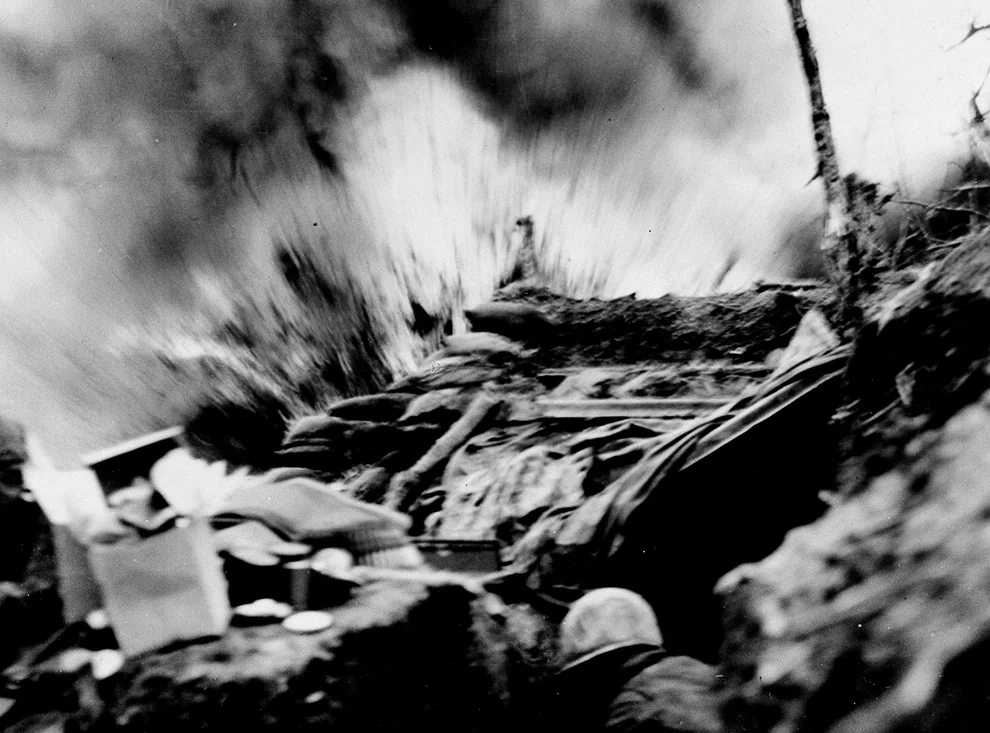
43
A U.S. Marine dives for cover in his bunker as a communist 82 millimeter mortar shell scores a hit on a ridge in eastern Korea, April 8, 1952. (AP Photo/Edward A. McDade/U.S. Navy) #
1952年4月8日,在朝鲜东部,一名美国海军陆战队士兵从碉堡中纵身一跃,躲开了即将坠向山坡上的共军82毫米迫击炮弹壳。(美联社照片/ Edward A. McDade/ 美国海军)
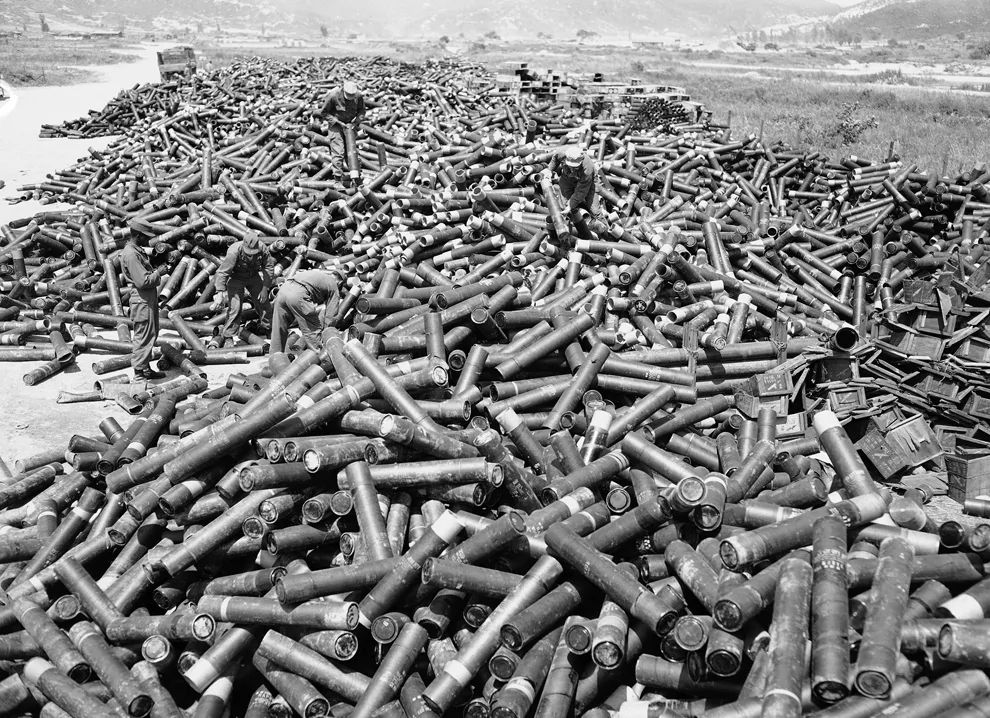
44
GIs and Korean service corpsmen stack up the enormous pile of empty artillery and mortar shell casings at a collecting point near the front, pointing to the huge amount of lead thrown at the enemy in four days of fighting for outpost Harry, June 18, 1953. (AP Photo/Gene Smith) #
1953年1月18日,美国兵和韩国的服役人员将火炮和迫击炮的空弹壳垒在一处集中地,这些弹药是在为拿下铁三角地的4天中攻击所消耗的。(美联社照片/ Gene Smith)
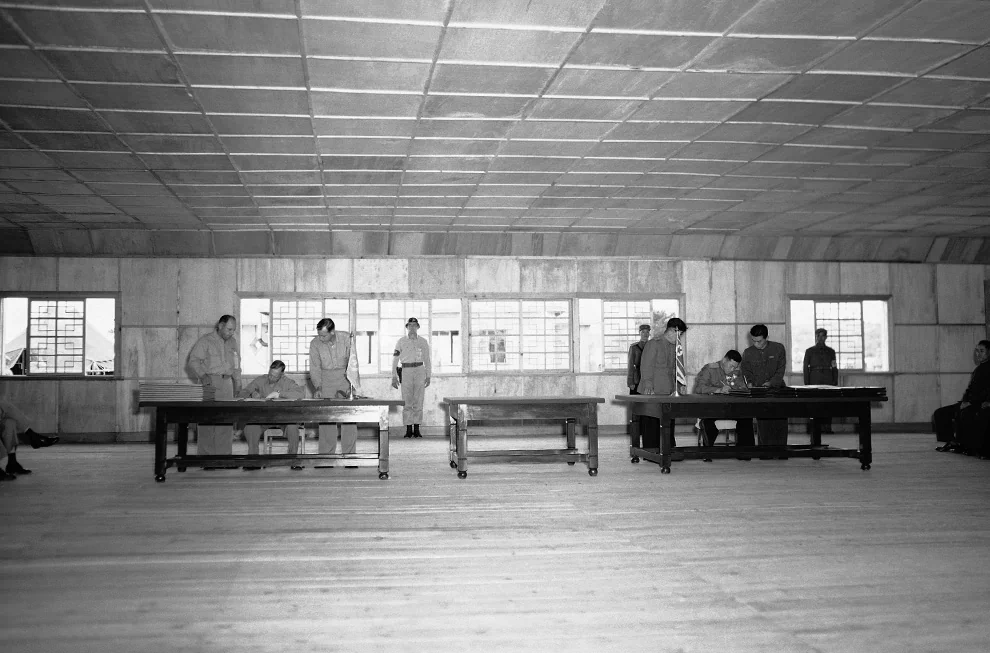
45
The interior of Bruce house - General William K. Harrison (left) and General Nam II (right) sign the armistice agreement which brought the Korean War to a close in Panmunjom on July 27, 1953. (AP Photo) #
1953年7月27日,在板门店,William K. Harrison上将(图左)和Nam II上将(图右)签署了朝鲜战争的停火协议。(美联社照片)
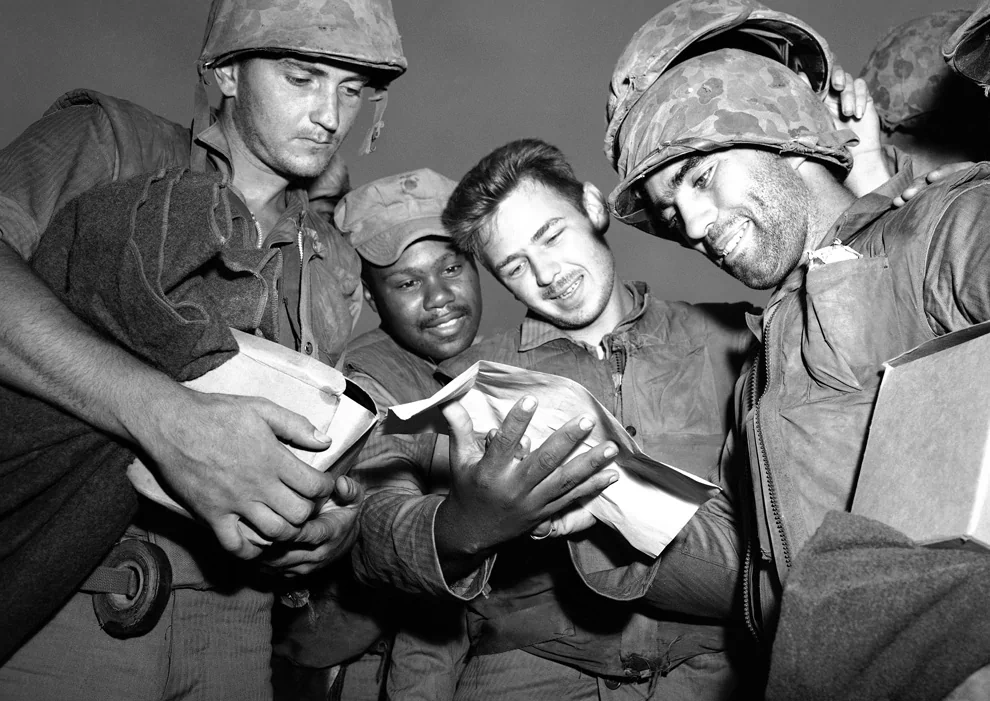
46
Four tired, bearded and grimy U.S. Marines just off the fighting line on western Korean front, read good news in an official handout that armistice to end war was about to be signed at Panmunjom on July 26, 1953. Identifiable at right is PFC Thomas W. O'Connell of Hammond, Wisconsin. (AP Photo/George Sweers) #
1953年7月,美国海军陆战队的4名刚从朝鲜西部锋线上归来的战士,胡子拉碴、疲惫不堪、满身尘土。他们读着官方材料里的新闻,了解到停火协议就要在26日签署了。图中右手的是威斯康星州哈蒙德的一等兵 Thomas W. O'Connell。(美联社照片/ George Sweers)
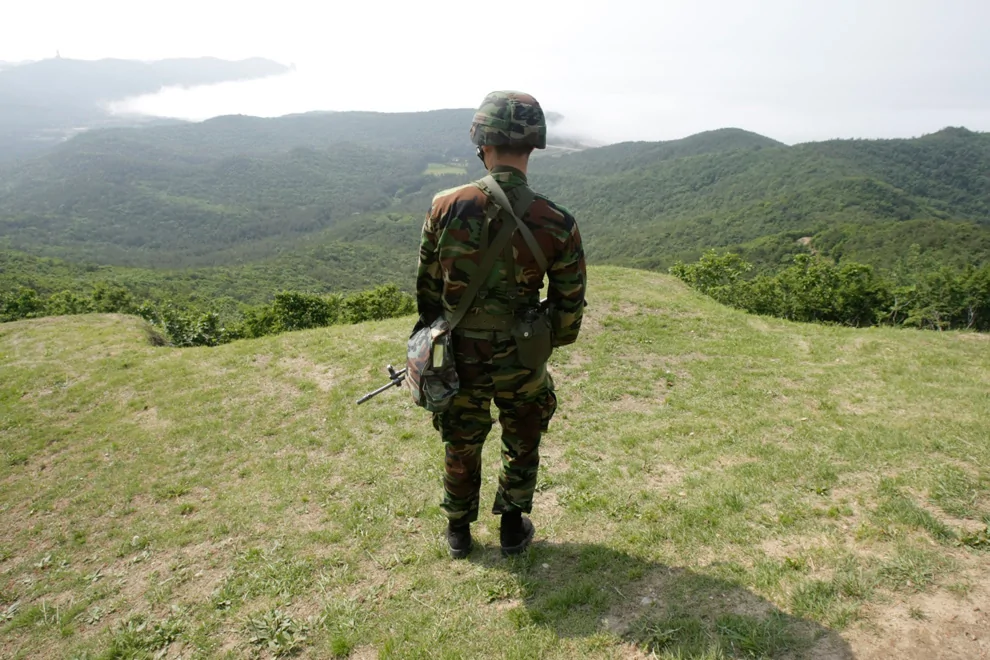
47
In this photo taken on Tuesday, June 15, 2010, a South Korean Marine looks at the North Korean side as he stands guard on Baengnyeong Island, South Korea, near the border with North Korea. (AP Photo/Ahn Young-joon) #
2010年6月15日,周二,一名韩国海军陆战队士兵在白翎岛站岗,眼望韩朝边境。(美联社照片/ Ahn Young-joon)
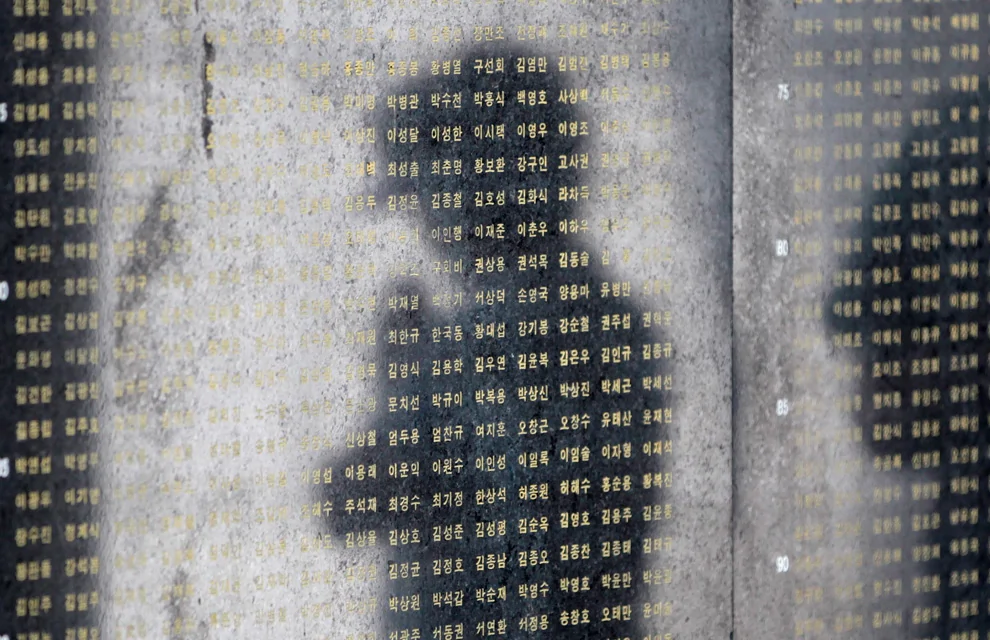
48
A woman is reflected on the names of the people who died during the 1950-53 Korean War as she prays for the fallen sailors from the sunken South Korean naval ship Cheonan at the Korean War Memorial Museum in Seoul June 20, 2010. (REUTERS/Jo Yong-Hak) # 2010年6月20日,在韩国首尔的朝鲜战争纪念馆里,一位女士为韩国海军天安舰沉海时丧生的水手祈祷。她的身影掩映在朝鲜战争牺牲战士的纪念碑上。(路透社/ Jo Yong-Hak)


















